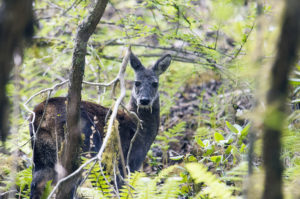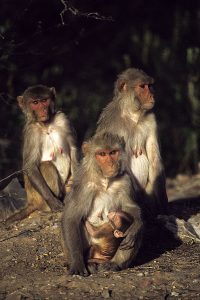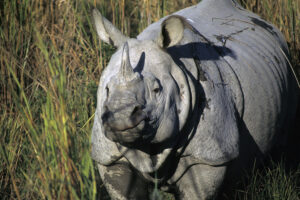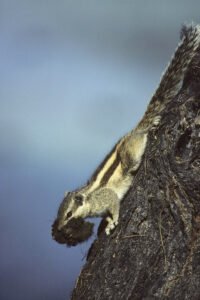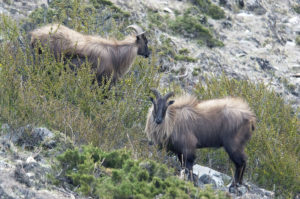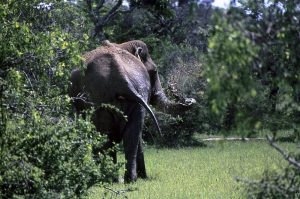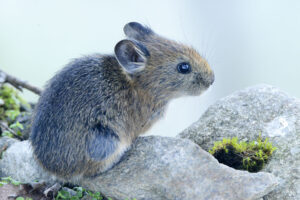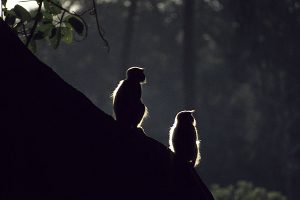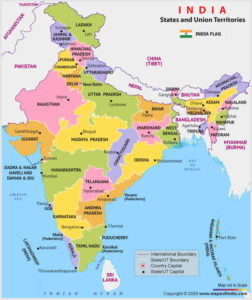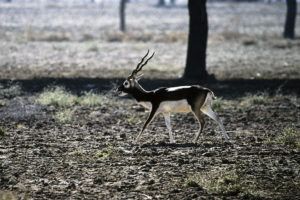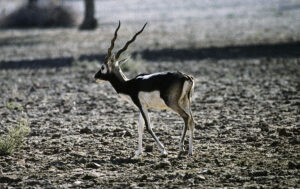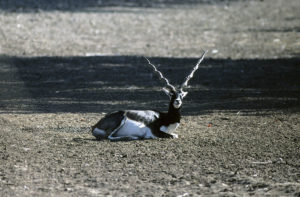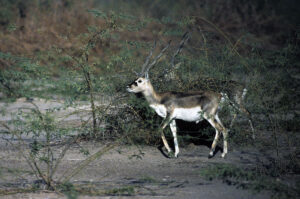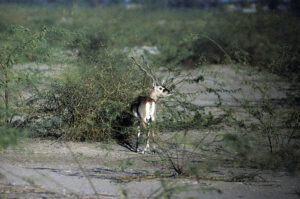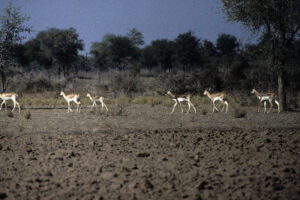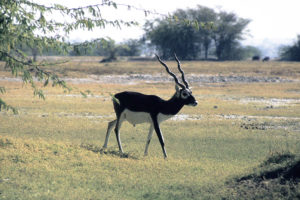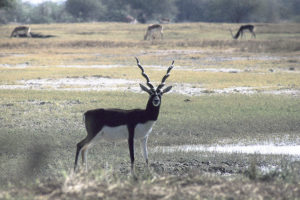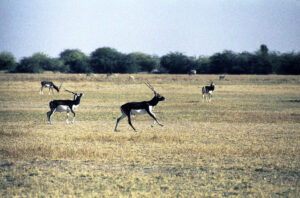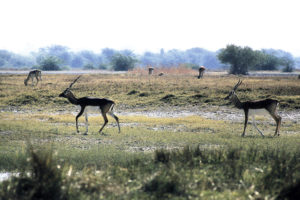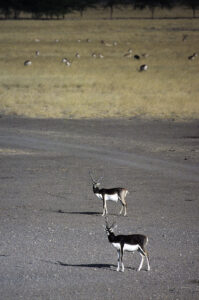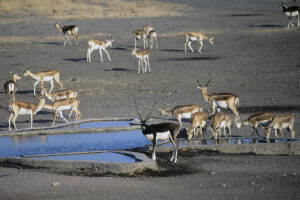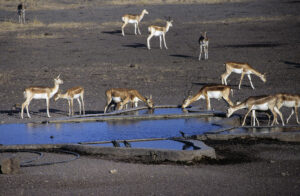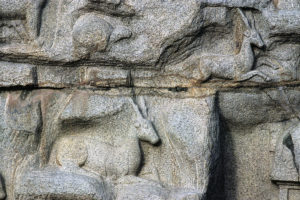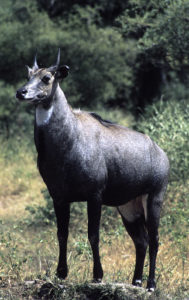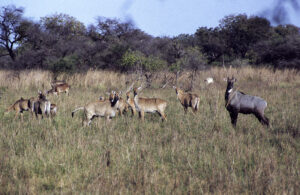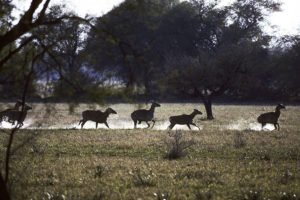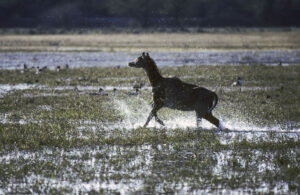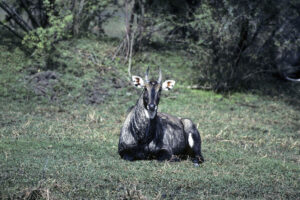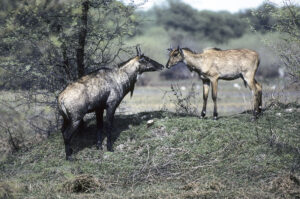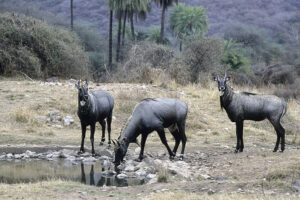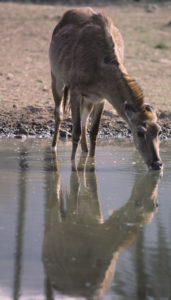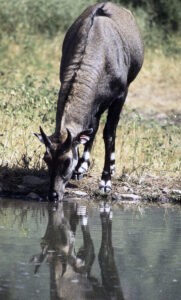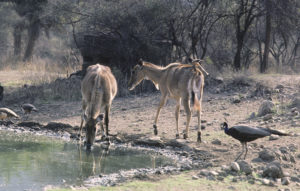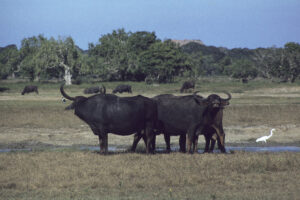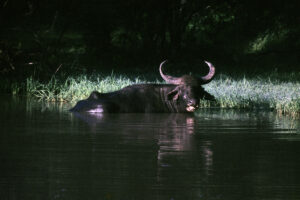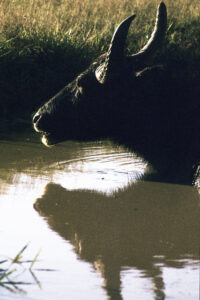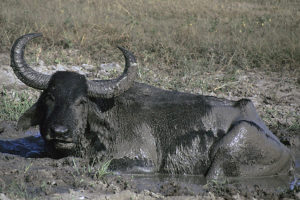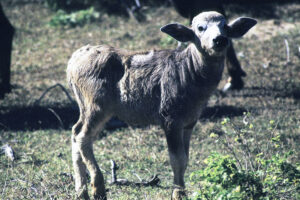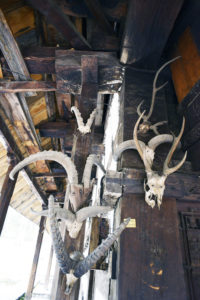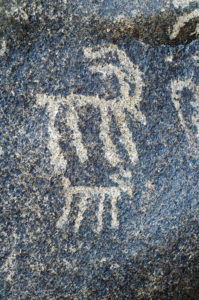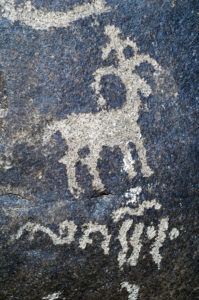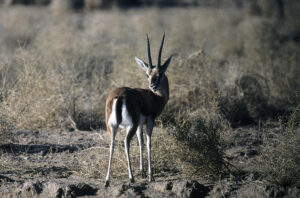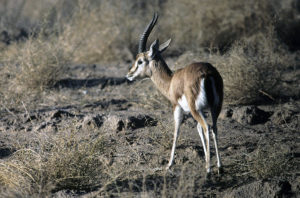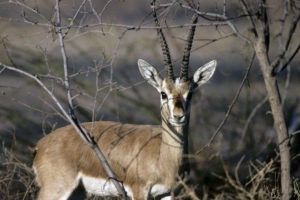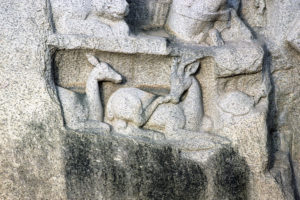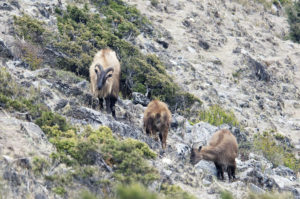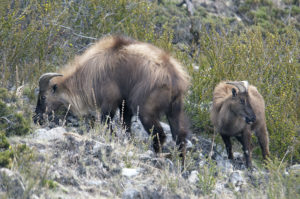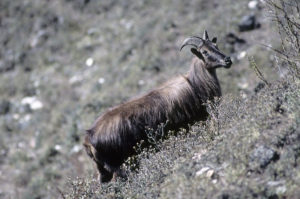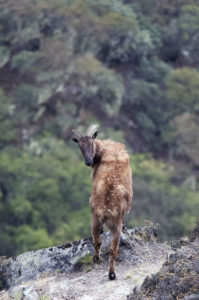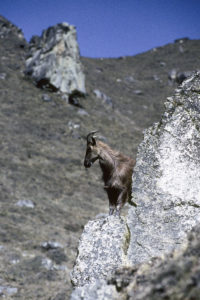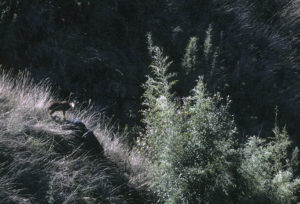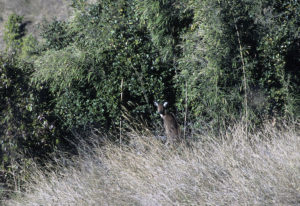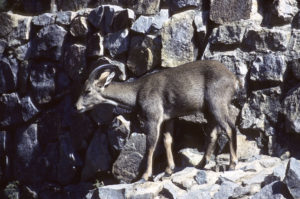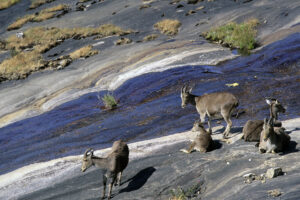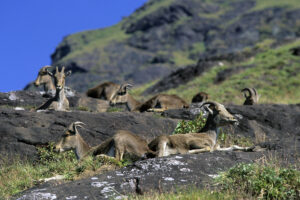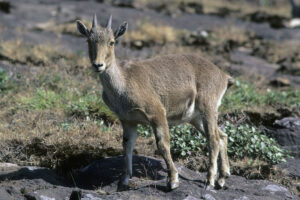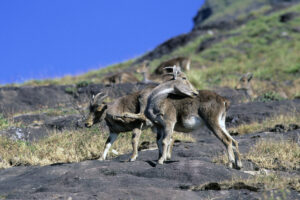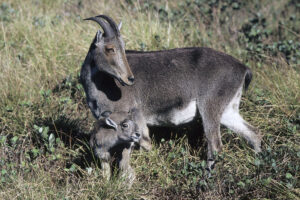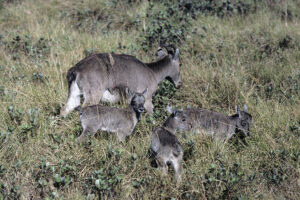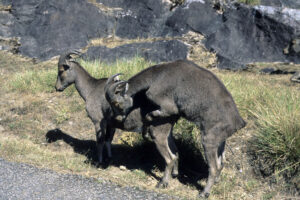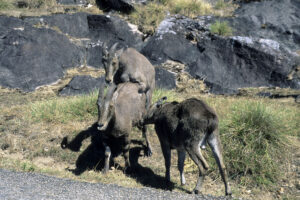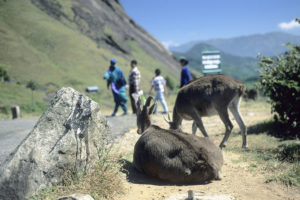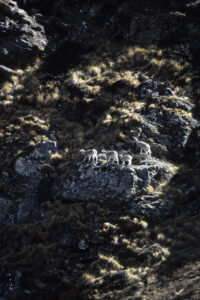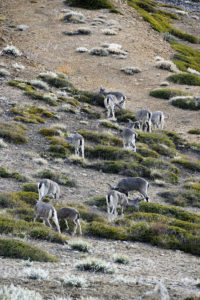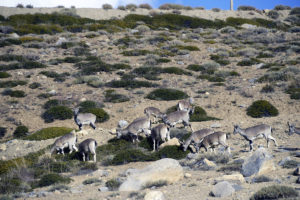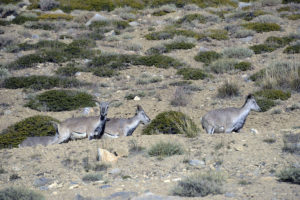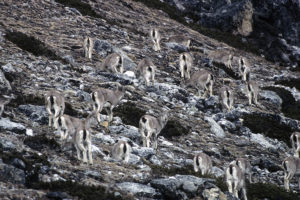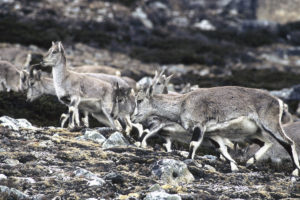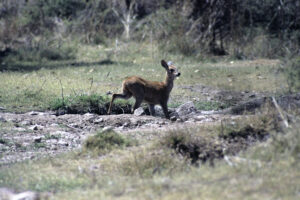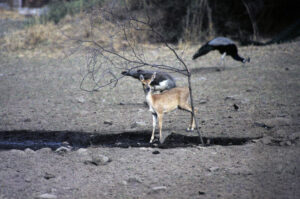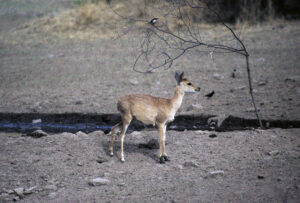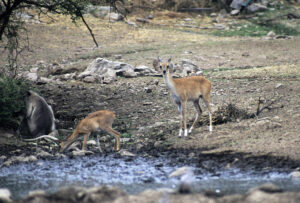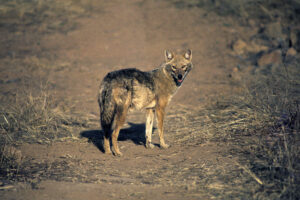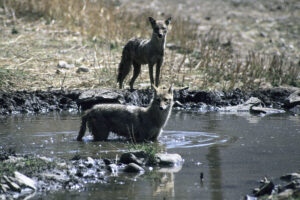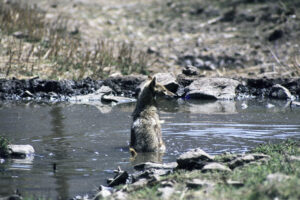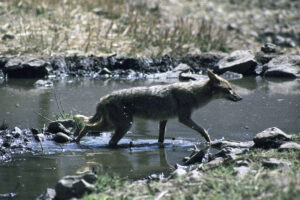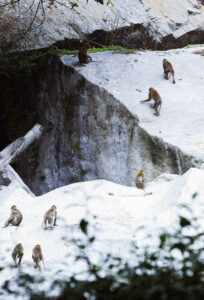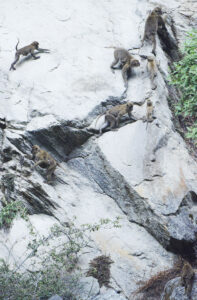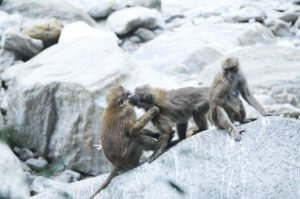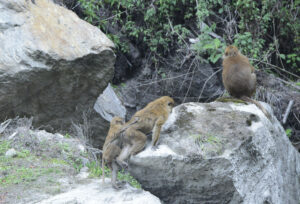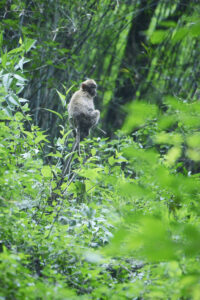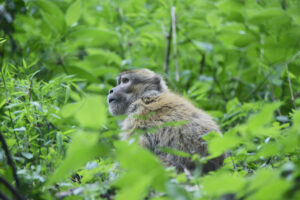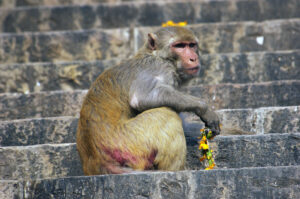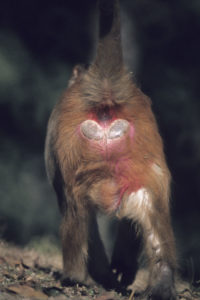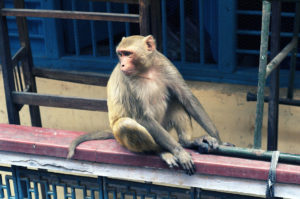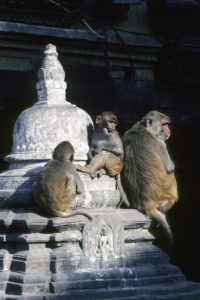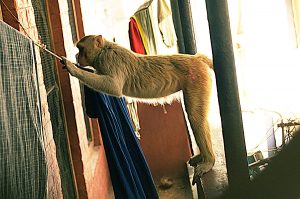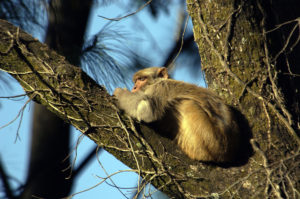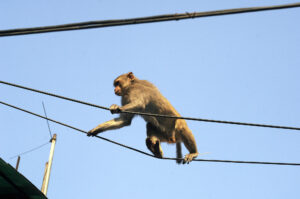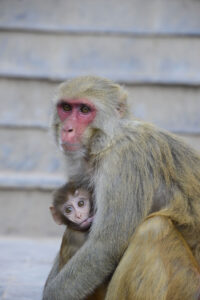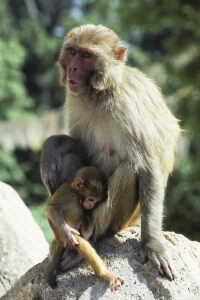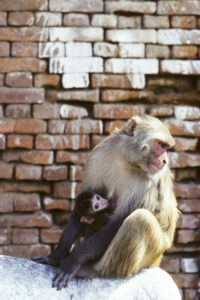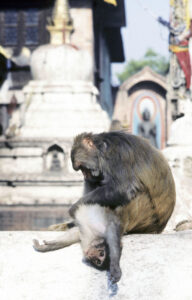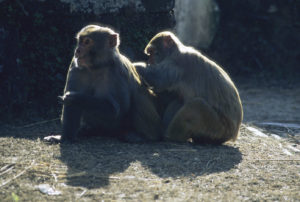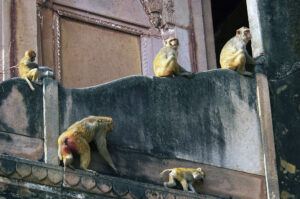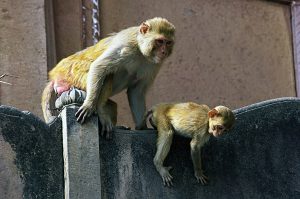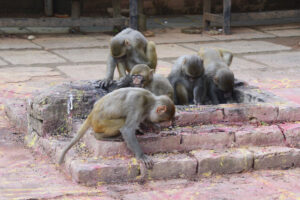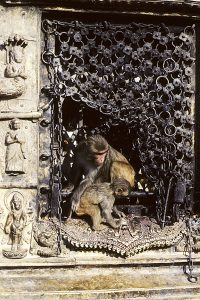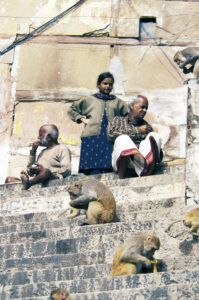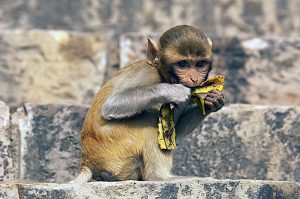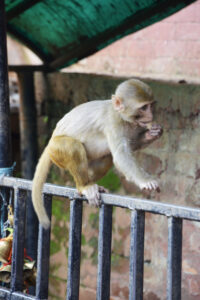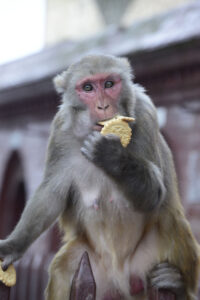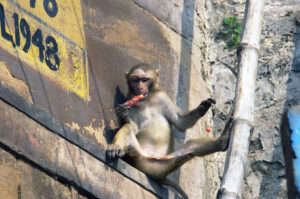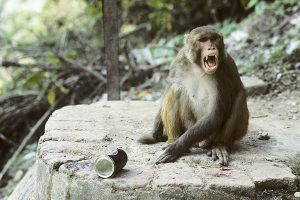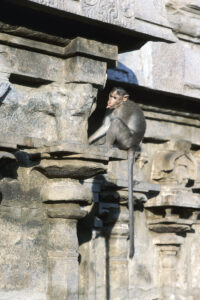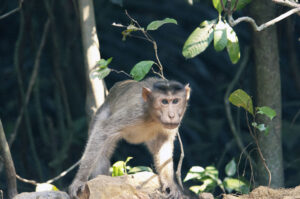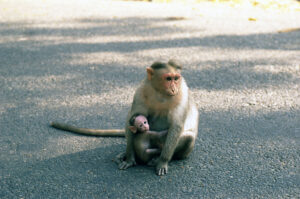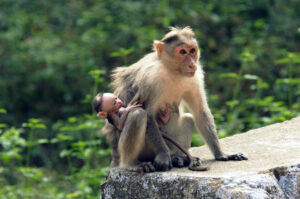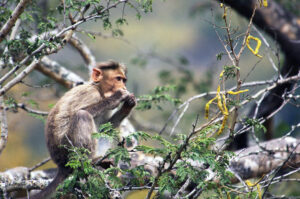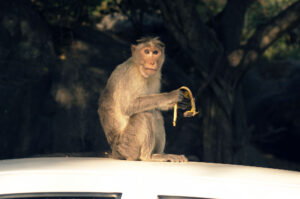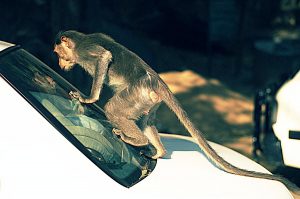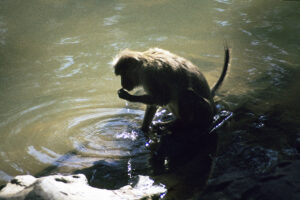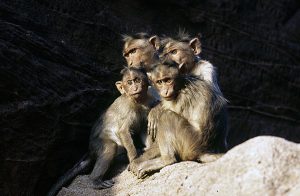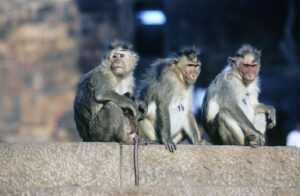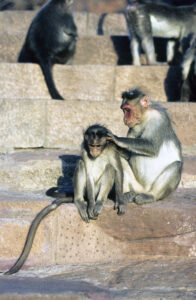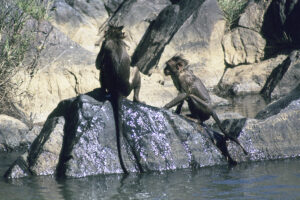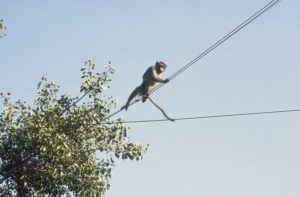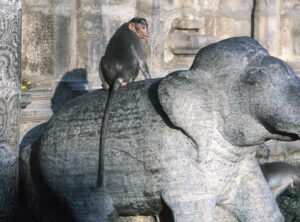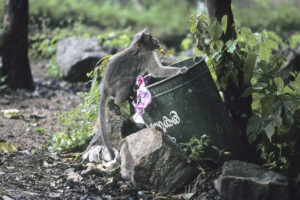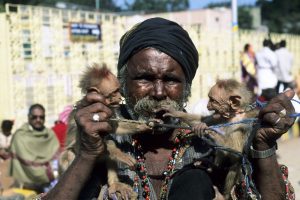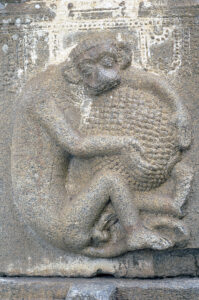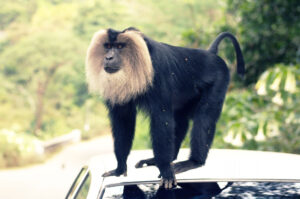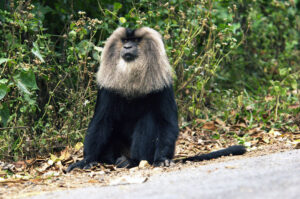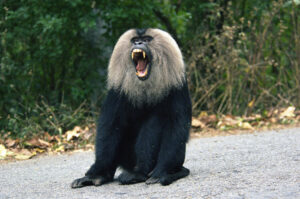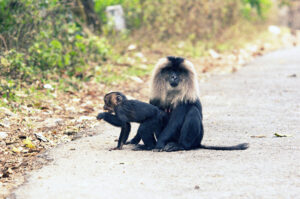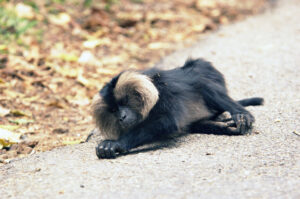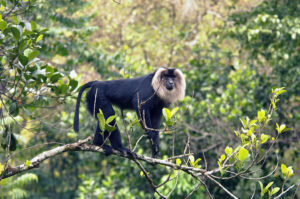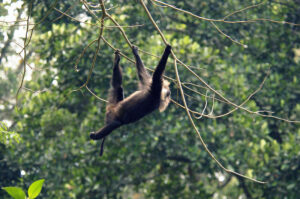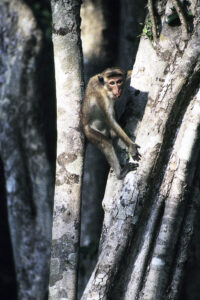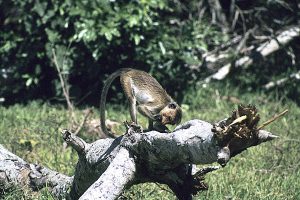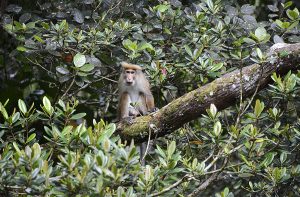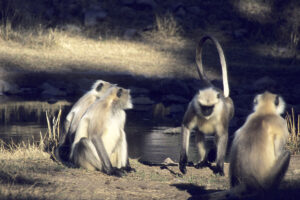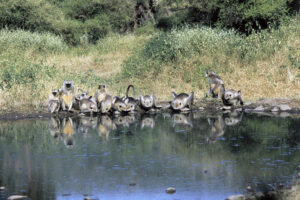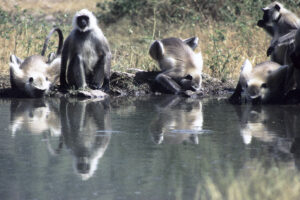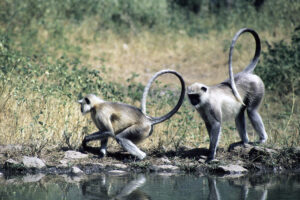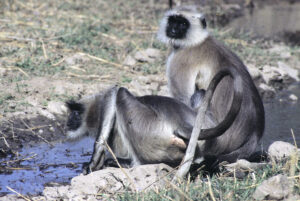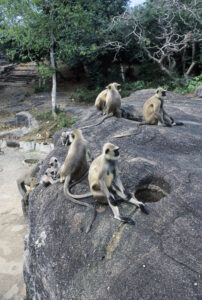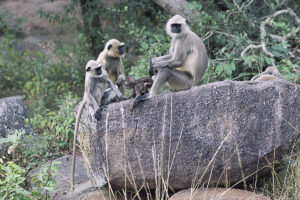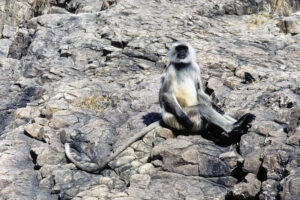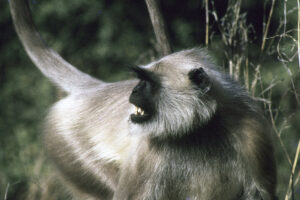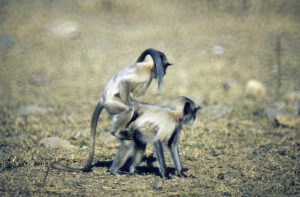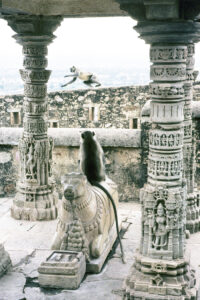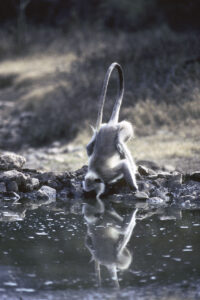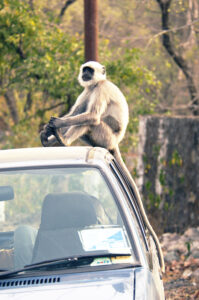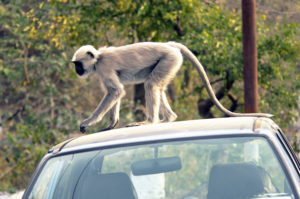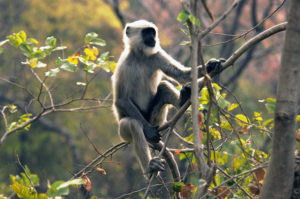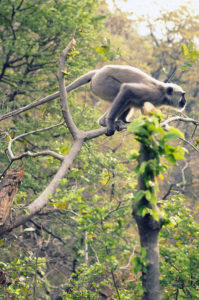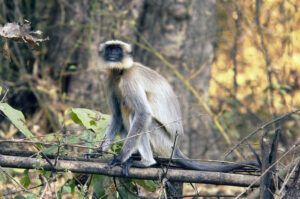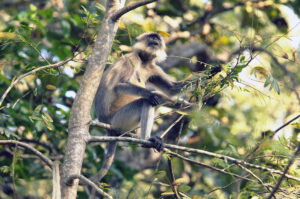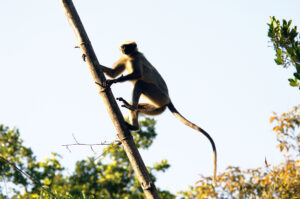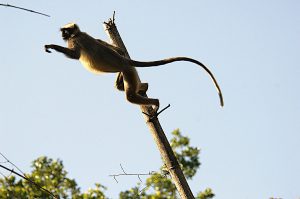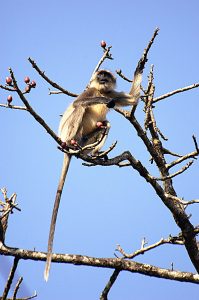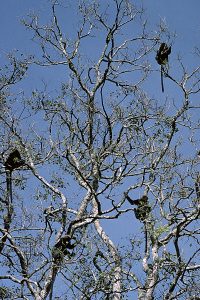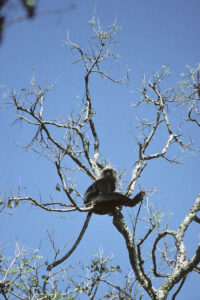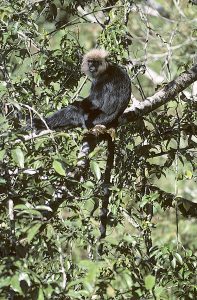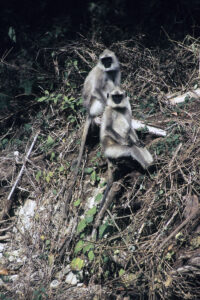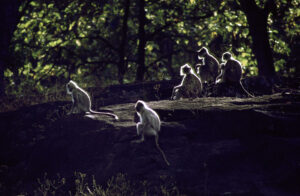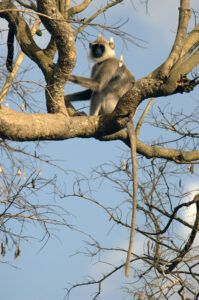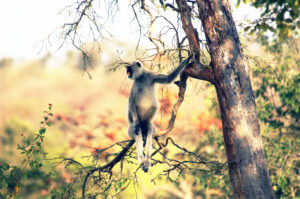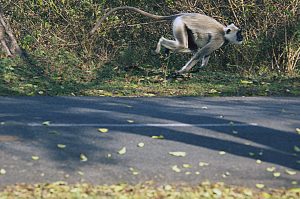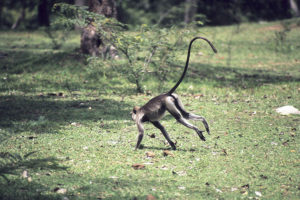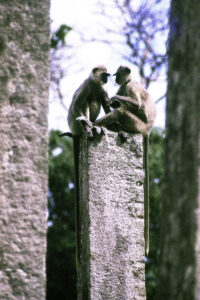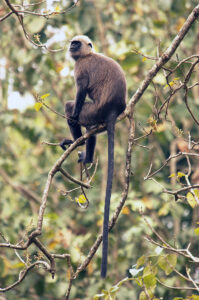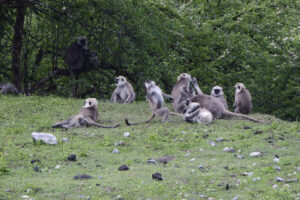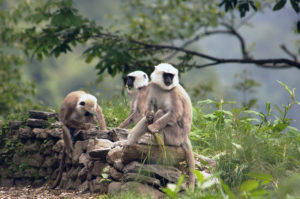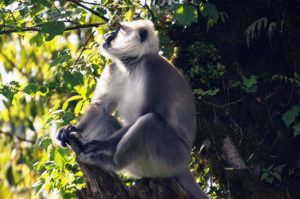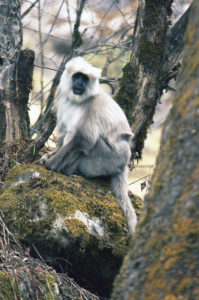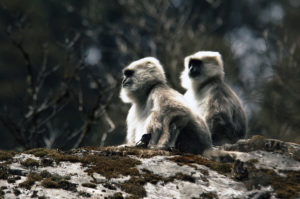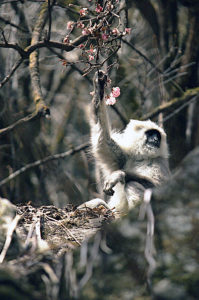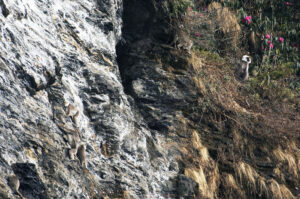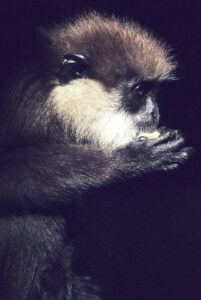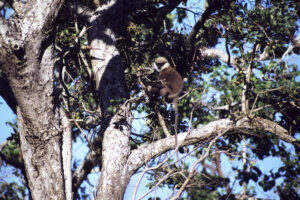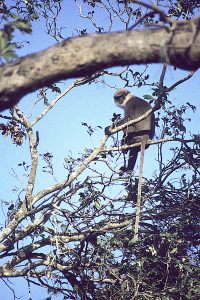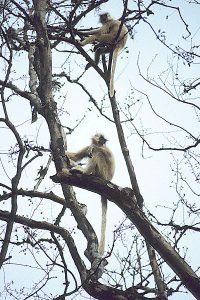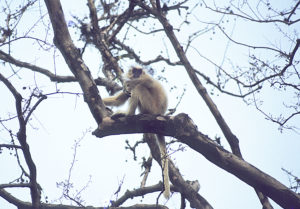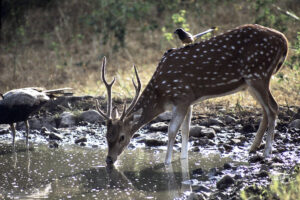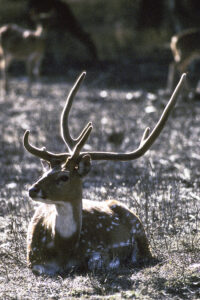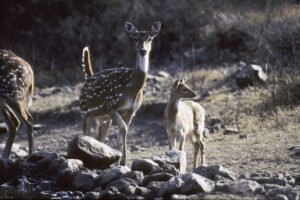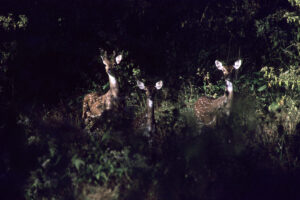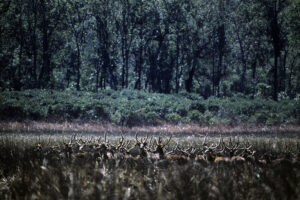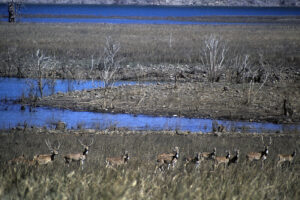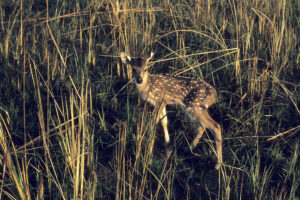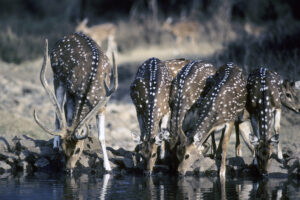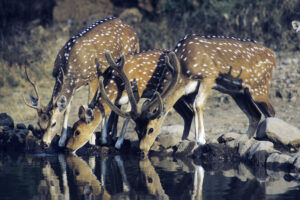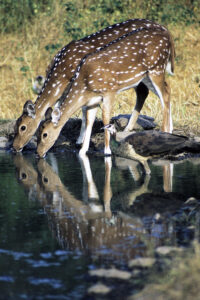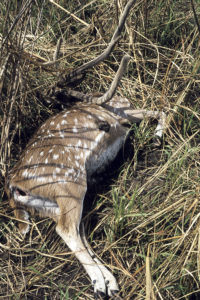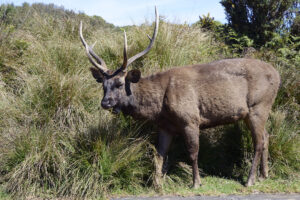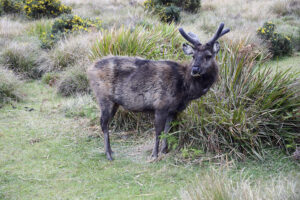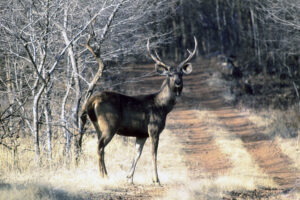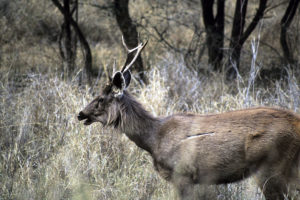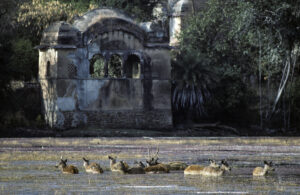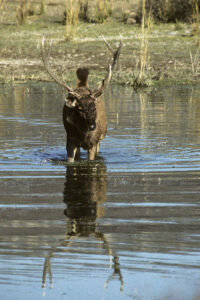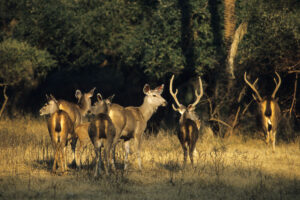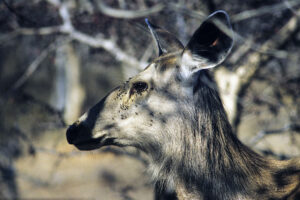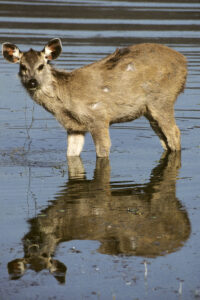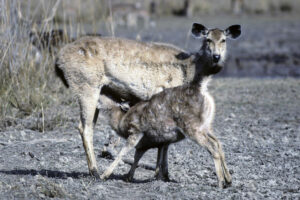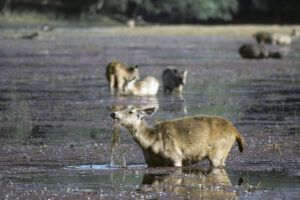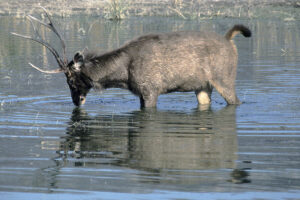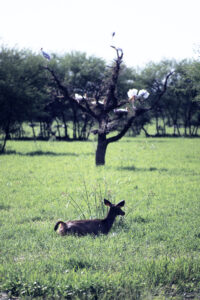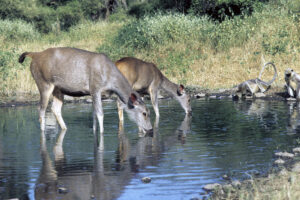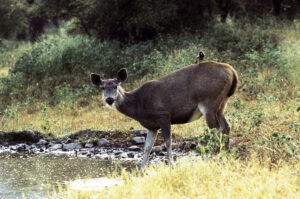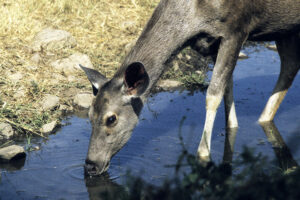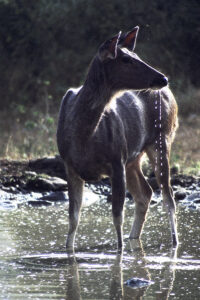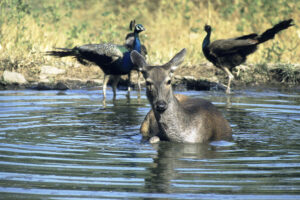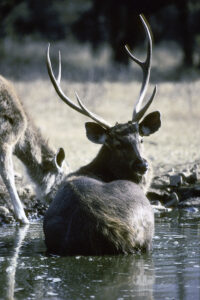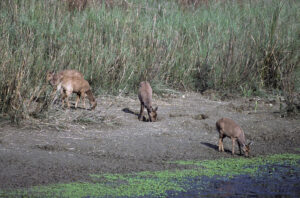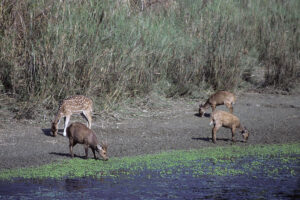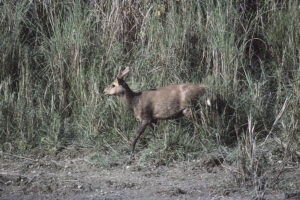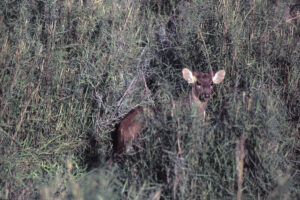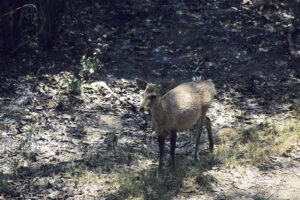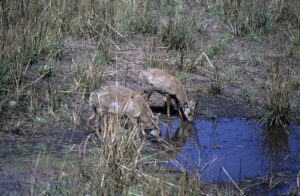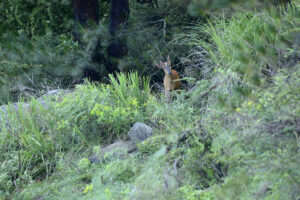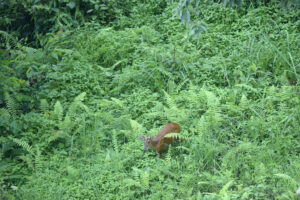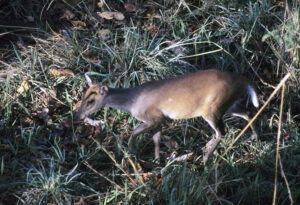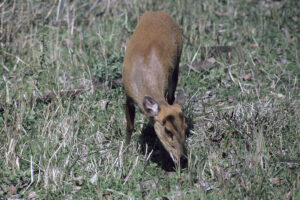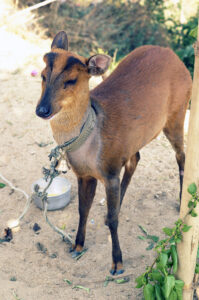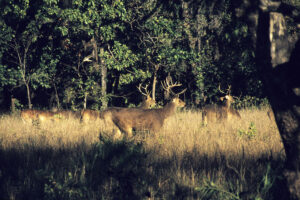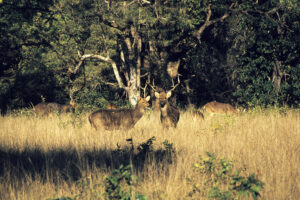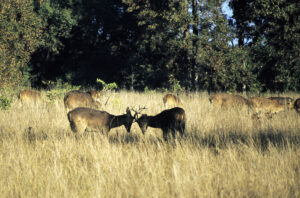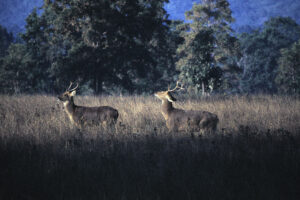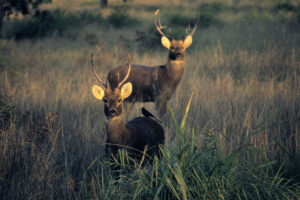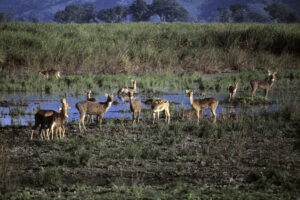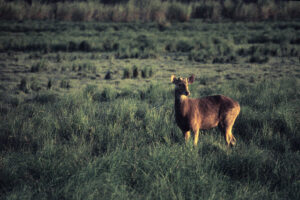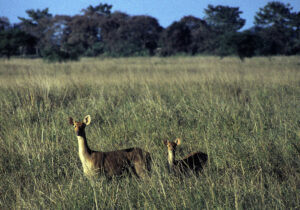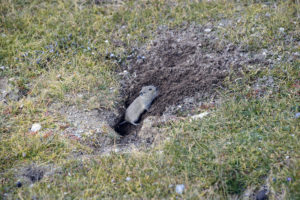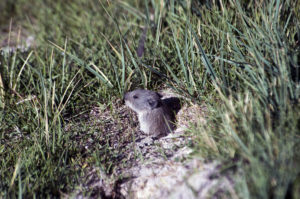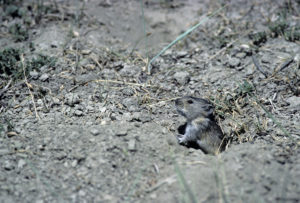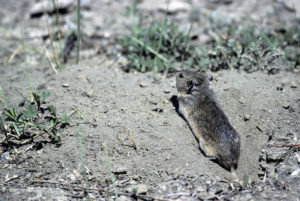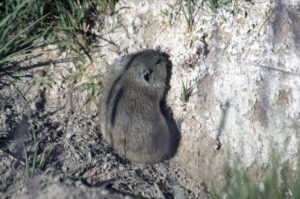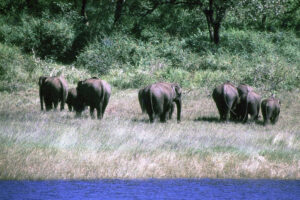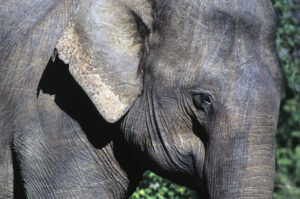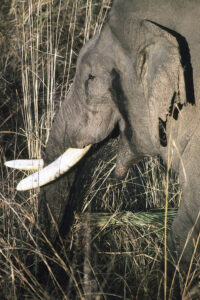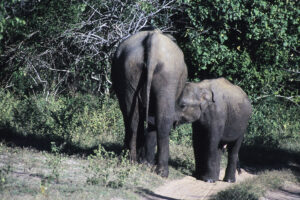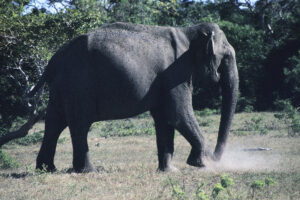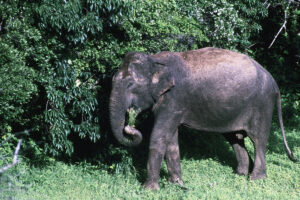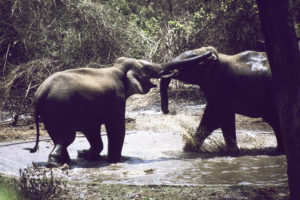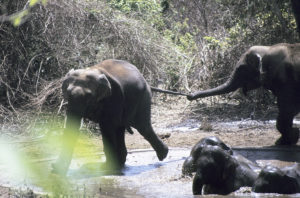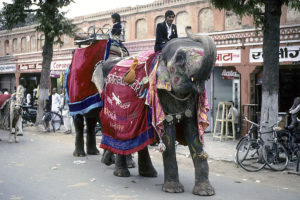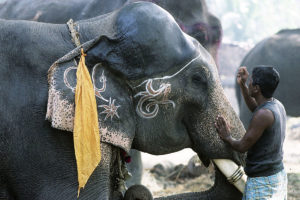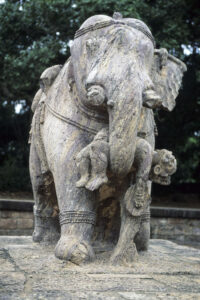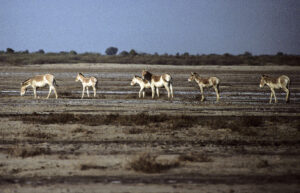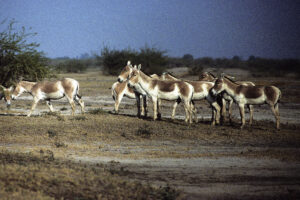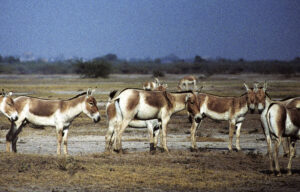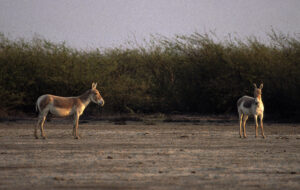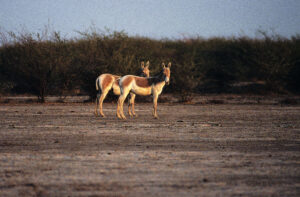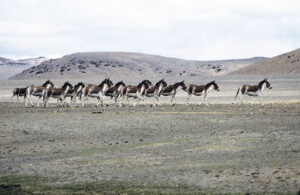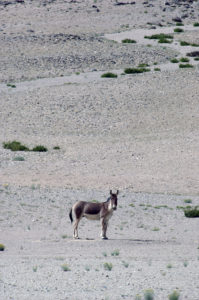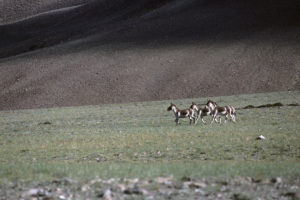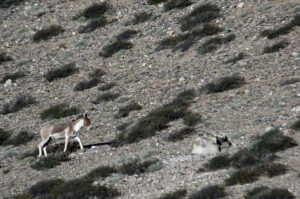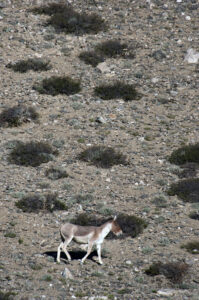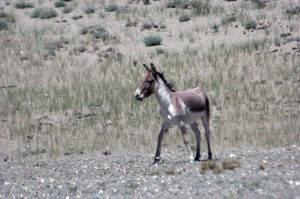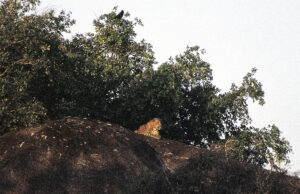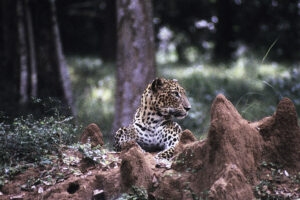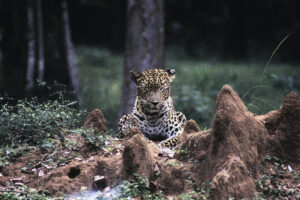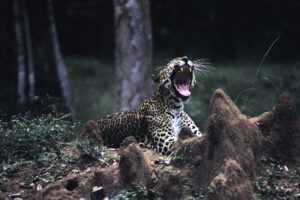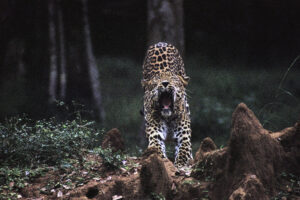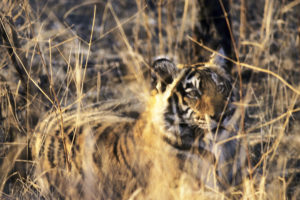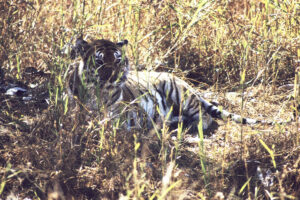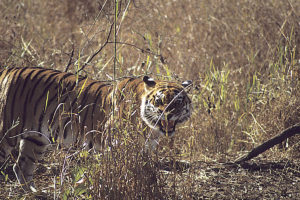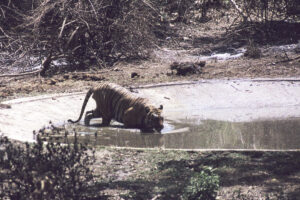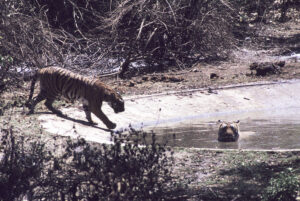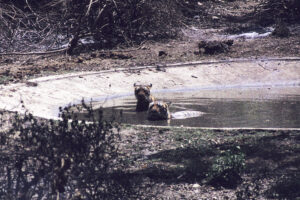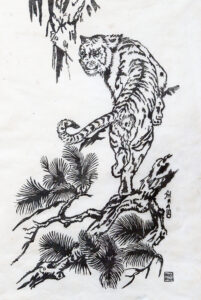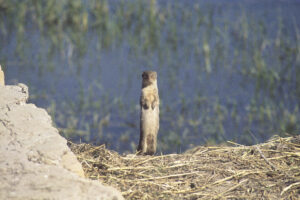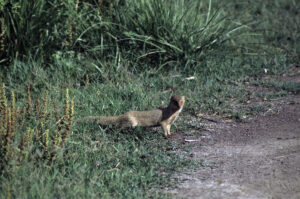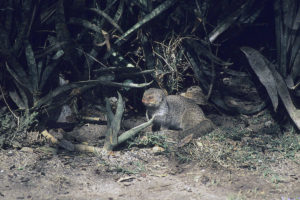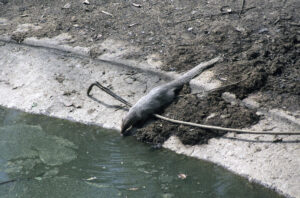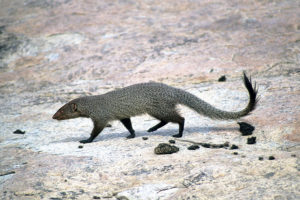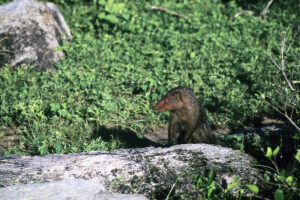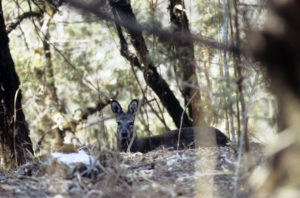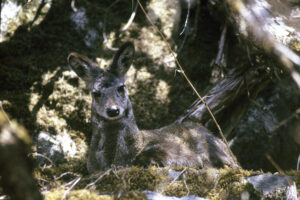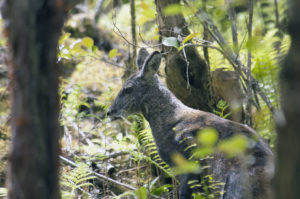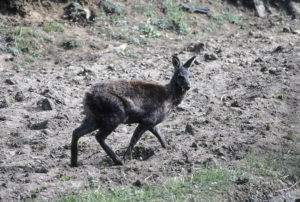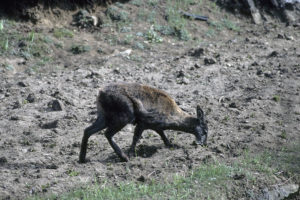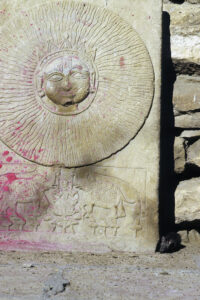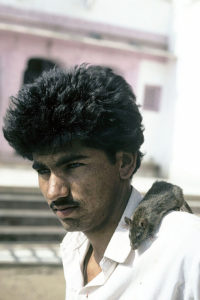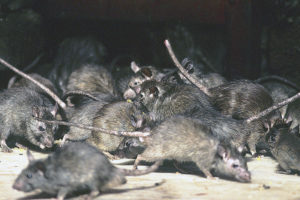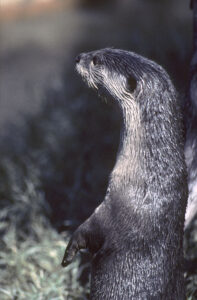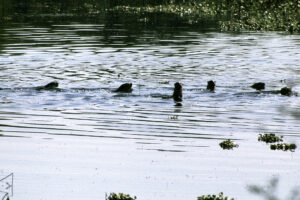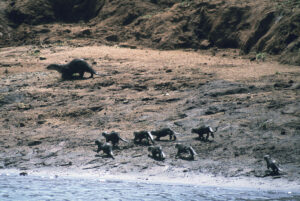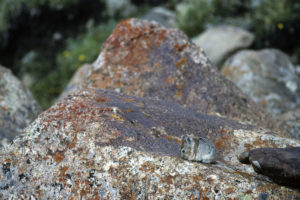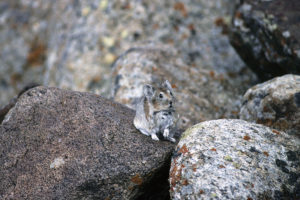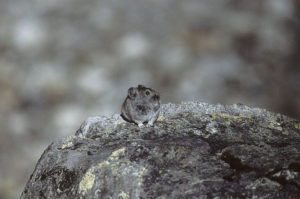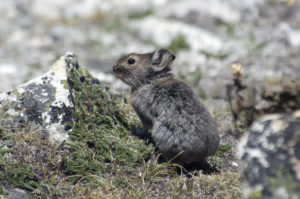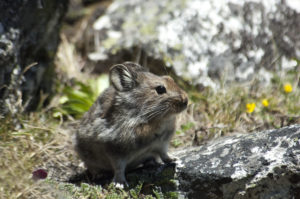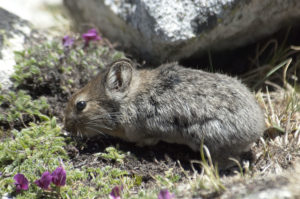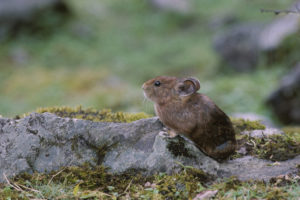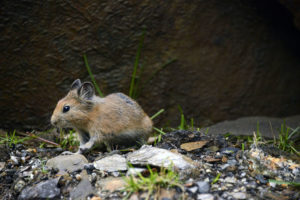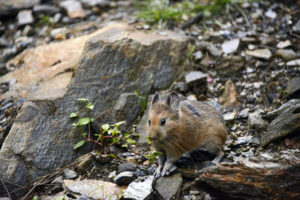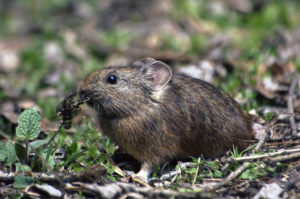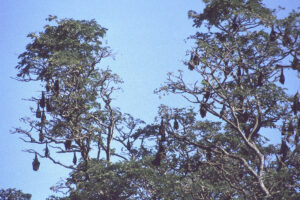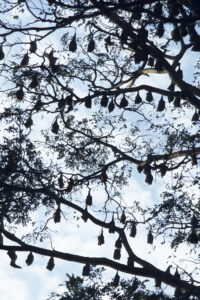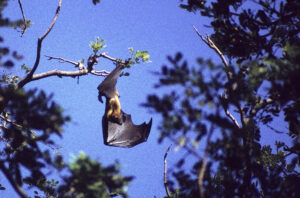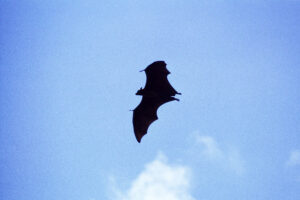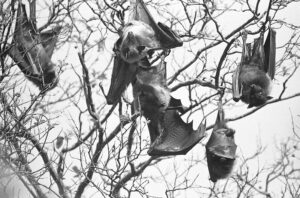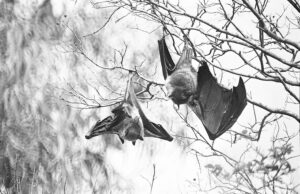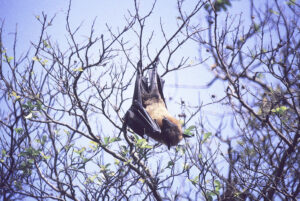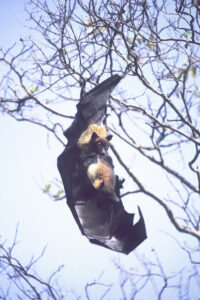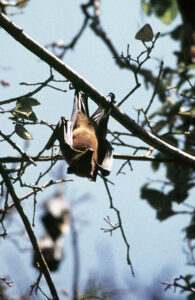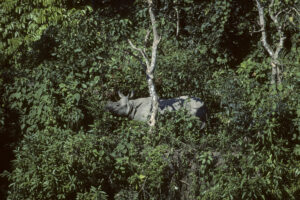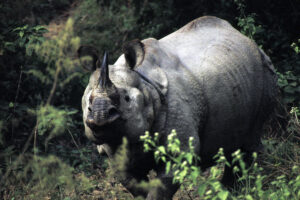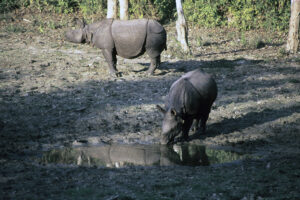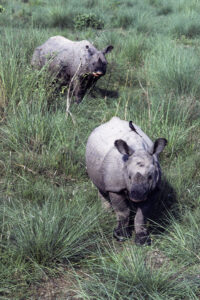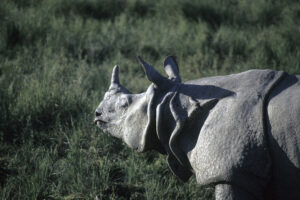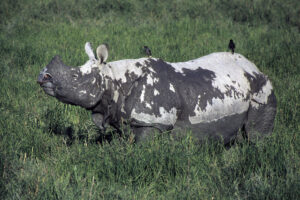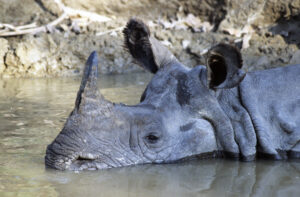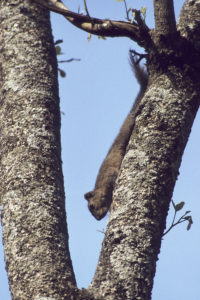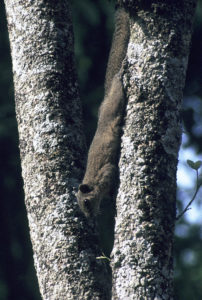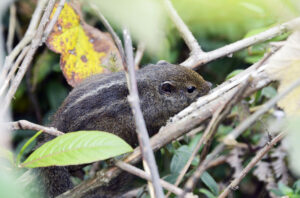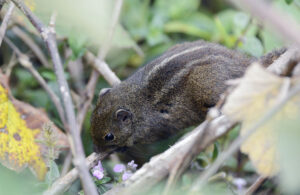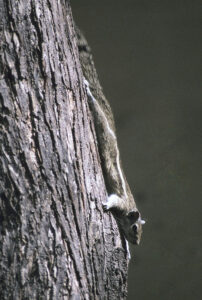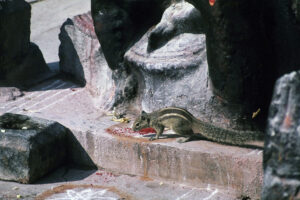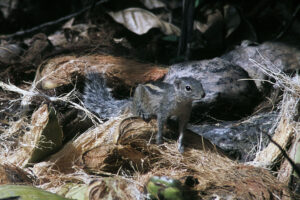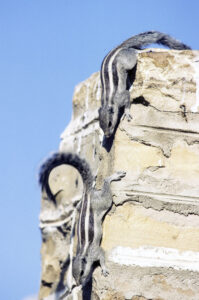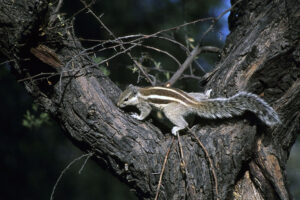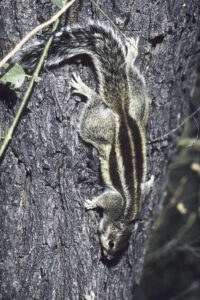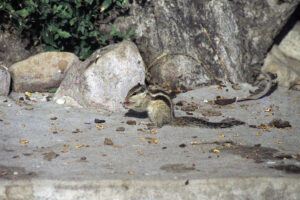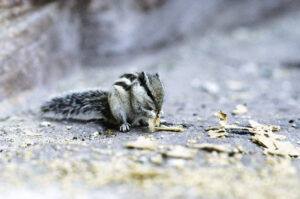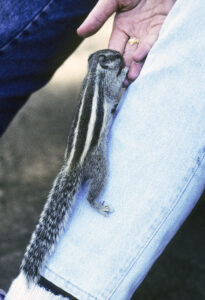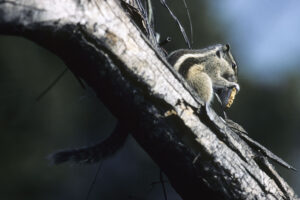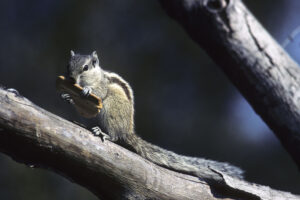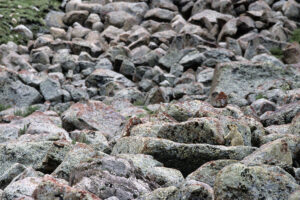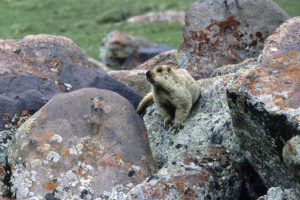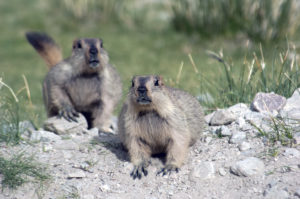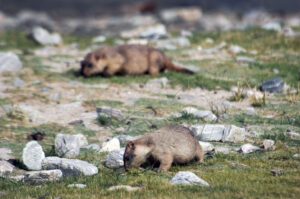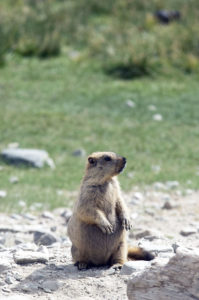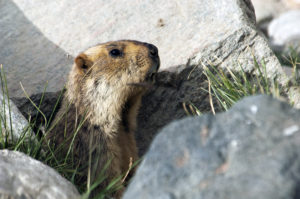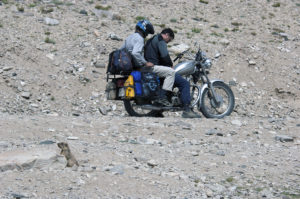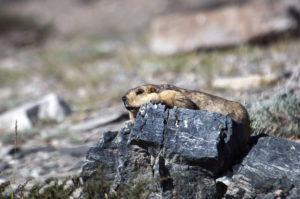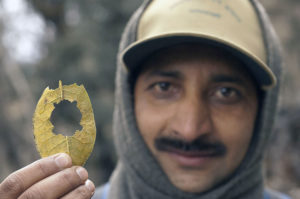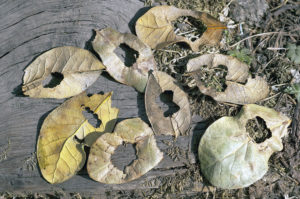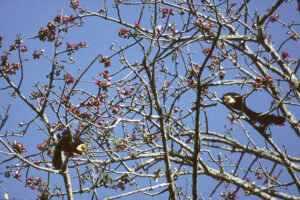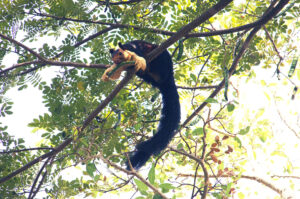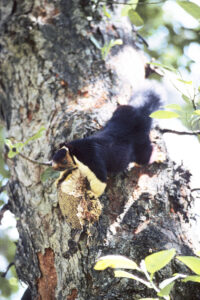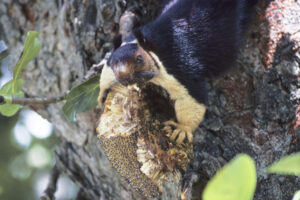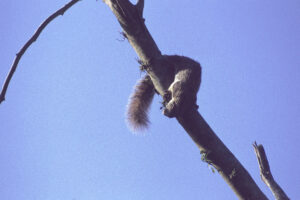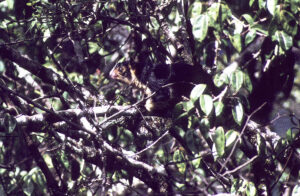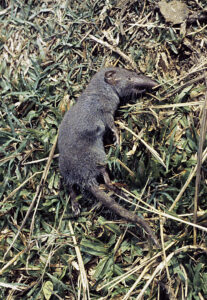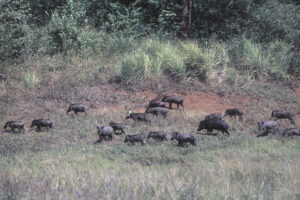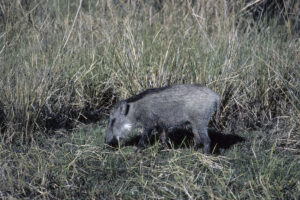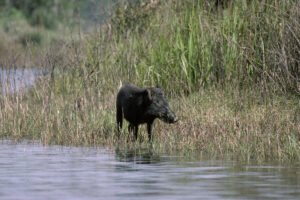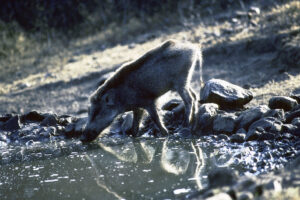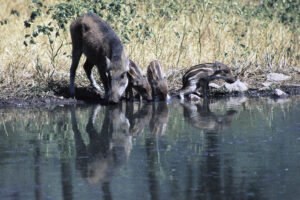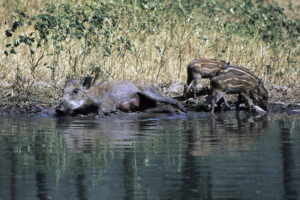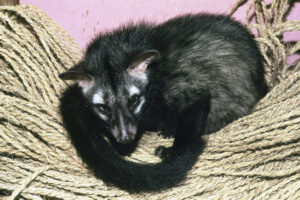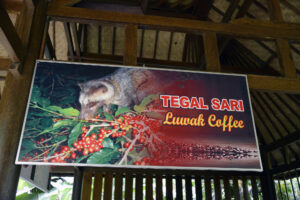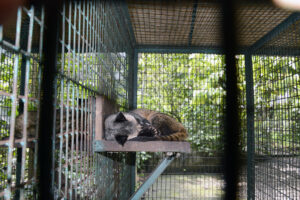Mammals in the Indian Subcontinent
This male alpine musk deer (Moschus chrysogaster) is enjoying his meal of old-man’s-beard lichens (Usnea), which have fallen to the ground in the forest below the Tengboche Monastery, Khumbu, eastern Nepal. (Photo copyright © by Kaj Halberg)
Female rhesus monkeys (Macaca mulatta), enjoying the evening sun in Sariska National Park, Rajasthan. The one in front is suckling its young. (Photo copyright © by Kaj Halberg)
Greater one-horned rhinoceros (Rhinoceros unicornis) in Kaziranga National Park, Assam – one of the few strongholds of the species. (Photo copyright © by Kaj Halberg)
Five-striped palm-squirrel (Funambulus pennantii) with nesting material, Keoladeo National Park, Rajasthan. (Photo copyright © by Kaj Halberg)
Himalayan tahr (Hemitragus jemlahicus) males, grazing in the Khumbu area, eastern Nepal, where this species is common. The animals are not harmed by the local Buddhist Sherpas. (Photo copyright © by Kaj Halberg)
Asian elephant (Elephas maximus), using the trunk to spray mud on its body. The purpose is probably to cool down, and perhaps the mud cake also protects its skin against stinging insects. – Yala National Park, Sri Lanka. (Photo copyright © by Kaj Halberg)
This Royle’s pika (Ochotona roylei), encountered at Phedi, near Gosainkund, Langtang National Park, central Nepal, was remarkably confiding, scurrying about between our feet. (Photo copyright © by Kaj Halberg)
Northern plains langurs (Semnopithecus entellus), silhouetted against the light, Ranthambhor National Park, Rajasthan. (Photo copyright © by Kaj Halberg)
This page deals with a selection of mammals, which I have encountered during my travels in the Indian Subcontinent since 1974. Families, genera and species are presented in alphabetical order.
Tibet (called Xizang by the Chinese), Qinghai, and Xinjiang are treated as separate areas. The term ‘western China’ indicates Chinese territories just east of Tibet and Qinghai. The term ‘south-western China’ includes the provinces Yunnan, Guizhou, and Sichuan.
As is obvious from most of the pictures below, I like to show the animals in their natural surroundings, or studies of their behaviour.
In case you find any errors on this page, I would be grateful to receive an email. You may use the address at the bottom of the page.
Map, showing Indian states and union territories. (Borrowed from www.mapsofindia.com)
Bovidae
This large family, comprising about 47 genera and c. 143 species, are cloven-hoofed, ruminant animals, including cattle, antelopes, sheep, goats, and many others. Members occur in Eurasia, Africa, and North America, and the water buffalo (below) has become feral in Australia.
Many species of antelope are presented on the page Animals – Mammals: Antelopes.
Antilope cervicapra Blackbuck
The male of this species is a wonderful creature: coal black, with white markings on face, legs and belly, and long, straight, spiralled horns, growing to 65 cm long in some individuals. During territorial battles, the males spar with their horns, trying to gather as many females as possible for their harem. Females and young males have more subtle colours, being brown and white.
Formerly, this gorgeous animal was distributed all over plains and semi-deserts in India and Pakistan, but uncontrolled hunting by British and Indian ‘sportsmen’ (as they were fond of calling themselves), and competition from grazing cattle, goats and sheep, took their toll.
The blackbuck disappeared completely from Pakistan, and from most of India. Larger herds survived only in the states of Rajasthan and Gujarat, mainly because the animals were protected by the Bishnoi and other local peoples. Traditionally, they protect all wild animals, even allowing them to graze in their fields of wheat and lentils. Thanks to their protection of the blackbuck, biologists have been able to re-introduce the species to many locations in India.
The blackbuck also plays a role in Hindu mythology, where the chariot of the moon god Chandrama is pulled by this animal.
The specific name is derived from the Latin cervus (‘deer’) and capra (‘she-goat’), thus ‘deer-goat’.
At the outskirts of the town of Mamallapuram, Tamil Nadu, a huge sculpture, measuring c. 15 by 30 m, has been carved into two boulders. The main theme of this sculpture, which has been dubbed The Descent of the Ganges, is an event in the Hindu epic Mahabharatha. Bhagiratha was a great king, doing penance for a thousand years to obtain the release of his 60,000 great-uncles from the curse of Saint Kapila, eventually leading to the descent of the goddess Ganga to Earth, in the form of River Ganges. However, many other themes have been included in the sculpture, including animals like elephants, cats, and blackbuck.
My difficulties to obtain permission to photograph blackbuck in Tal Chapar Wildlife Sanctuary are related on the page Travel episodes – India 1979: Hunting blackbuck with camera.
Adult male blackbuck, Gudi, near Osiyan, Rajasthan. (Photos copyright © by Kaj Halberg)
Sub-adult males with brownish parts, Gudi. (Photos copyright © by Kaj Halberg)
Females and sub-adult males, Gudi. (Photo copyright © by Kaj Halberg)
Adult male, Tal Chapar Wildlife Sanctuary, Rajasthan. (Photos copyright © by Kaj Halberg)
An adult male shows a threatening attitude towards another male, which runs away, Tal Chapar Wildlife Sanctuary. (Photo copyright © by Kaj Halberg)
Younger males, Tal Chapar Wildlife Sanctuary. (Photo copyright © by Kaj Halberg)
Blackbuck, Velavadar National Park, Gujarat. (Photos copyright © by Kaj Halberg)
Blackbuck at a waterhole, Velavadar National Park. (Photos copyright © by Kaj Halberg)
Detail of the sculpture ‘The Descent of the Ganges’ (see text above), depicting blackbuck. – Mamallapuram, Tamil Nadu. (Photo copyright © by Kaj Halberg)
Boselaphus tragocamelus Nilgai
This large, stout antelope, the only member of the genus, is distributed in the major part of India, and there is also a small population in southern Nepal. It is especially common in Rajasthan.
The name nilgai is Hindi, meaning ‘blue cow’, which refers to the slate-coloured, slightly bluish coat of the male, and to its similarity to the sacred cow. For the latter reason, the nilgai is protected by devout Hindus and has thus escaped the fate of many other animals in India, which are on the brink of extinction, such as the tiger (below), the lion (Panthera leo), and the blackbuck (above). The coat of females and young animals is a pale sandy brown. Both sexes have a white throat patch.
The scientific name of this antelope is quite peculiar. It is derived from four Greek words, bous (‘cow’), elaphos (‘deer’), tragos (‘goat’), and kamelos (‘camel’). The name was applied by Prussian naturalist Peter Simon Pallas (1741-1811), to whom this antelope apparently resembled a mixture of these four animals.
The slate-coloured, slightly bluish coat of the male nilgai, and its similarity to the sacred cow, have given rise to its name, which means ‘blue cow’ in Hindi. This bull was photographed in Sariska National Park, Rajasthan. (Photo copyright © by Kaj Halberg)
Cows and calves are pale brown with white chin and upper neck. Note the typical black-and-white markings on the ears. – Sariska National Park. (Photo copyright © by Kaj Halberg)
Nilgais, Keoladeo National Park, Rajasthan. (Photo copyright © by Kaj Halberg)
Nilgais, running across a swamp, Keoladeo National Park. (Photos copyright © by Kaj Halberg)
Resting nilgai bull, Keoladeo National Park. (Photo copyright © by Kaj Halberg)
Bull, greeting a young animal, Keoladeo National Park. (Photo copyright © by Kaj Halberg)
Nilgais, drinking from a waterhole, Sariska National Park. (Photos copyright © by Kaj Halberg)
A cow and a younger animal, drinking from a waterhole, Sariska National Park. A rufous treepie (Dendrocitta vagabunda) is sitting on the back of the young animal. Peafowl (Pavo cristatus) are also present. (Photo copyright © by Kaj Halberg)
Bubalus Asian buffaloes
This genus contains 4 or 5 species, the wild water buffalo (below), the tamaraw (B. mindorensis), found on the island Mindoro in the Philippines, the lowland anoa (B. depressicornis) and the mountain anoa (B. quarlesi), which are both restricted to Sulawesi, and finally the domestic water buffalo (below), which has no genuine wild populations, but feral populations exist in South America, Australia, and Sri Lanka.
The generic name is a Latinized version of Ancient Greek boubalos, the classical word for buffaloes.
Bubalus arnee Wild water buffalo
This magnificent animal is restricted to a few locations in north-eastern and central India, the Kosi Tappu Reserve in southern Nepal, and a single place in each of the countries Myanmar, Thailand, and Cambodia. It is believed that the global population is less than 3,400 individuals, of which about 3,100 live in India, mainly in Assam. As it is still declining, it has been listed as Endangered in the IUCN Red List.
The specific name is the Hindi name of this animal, also spelled arni.
Wild water buffaloes, Kaziranga National Park, Assam. The bird is a cattle egret (Bubulcus ibis). (Photo copyright © by Kaj Halberg)
Bubalus bubalis Domestic water buffalo
Research indicates that this animal most probably descended from the wild water buffalo. It was domesticated about 5,000 years ago, and today it is so different from the wild species that most authorities regard them as separate species.
The main difference between the two lies in the shape of the horns, which in the wild species are massive, spreading out sideways almost horizontally, only curving at the tip, whereas the horns of the domestic animals are smaller, curved almost from the base.
Traditionally, the water buffaloes, which live in the wild in several national parks in Sri Lanka, were regarded as wild buffaloes, but in all probability they descended from feral domestic buffaloes, as their horns are smaller than those of the genuine wild buffaloes in Assam.
Feral water buffaloes, Yala National Park, Sri Lanka. The bird to the right is a little egret (Egretta garzetta). (Photo copyright © by Kaj Halberg)
Water buffaloes, cooling off in water, Yala National Park. (Photos copyright © by Kaj Halberg)
Water buffalo, enjoying a mudbath, Yala National Park. (Photo copyright © by Kaj Halberg)
This calf in Yala National Park is unusually pale. (Photo copyright © by Kaj Halberg)
In Hindu mythology, Mahishasura was a powerful demon, who threatened the power of the gods, and not even the mighty gods Vishnu and Shiva could resist him. Then Durga, Shiva’s shakti (female aspect), took action. Riding on her lion, she attacked Mahishasura, who first changed into a huge buffalo, then into a lion. Durga sliced off his head, but he then changed into an elephant, whereupon Durga cut off his trunk. The demon hurled large mountains at the goddess, but, nevertheless, she managed to kill him with her spear.
Durga and other Hindu gods are described on the page Religion: Hinduism.
This sculpture in the great temple near Aihole, Karnataka, depicts Durga, riding on her lion, battling against Mahishasura, here in the shape of a buffalo. (Photo copyright © by Kaj Halberg)
Capra Goats
This genus contains about 9 species, including the domestic goat and several species of ibex. The domestic goat is presented in depth on the page Animals: Animals as servants of Man.
The generic name is the classical Latin word for a she-goat. A billy-goat was called caper.
Capra sibirica Siberian ibex
In former times, this goat was treated as a subspecies of the Alpine ibex (Capra ibex), and whether it is specifically distinct from other ibex is still not entirely clear. Traditionally, 4 subspecies have been recognized, but some authorities regard it as monotypic. In the Himalaya, subspecies sakeen occurs in Pakistan and north-western India, and it is also found in Afghanistan and the Pamir Mountains.
The Siberian ibex is a heavily built animal. Males measure 90-110 cm across the shoulder, weighing 60-130 kg, with horns typically about 115 cm long, although a length up to 148 cm has been recorded. Females are smaller, measuring 70-90 cm across the shoulder, weighing 35-56 kg, with horns measuring an average of 27 cm long. Both sexes also possess a scent gland beneath the tail. Their greyish coat is well suited for camouflage in mountains with low or no vegetation.
This picture is from the interesting Hindu temple Hadimba in Manali, Himachal Pradesh, which is adorned with various items, including ringed horns of Siberian ibex, smooth horns of bharal (Pseudois nayaur, see below), and antlers of Kashmir stag (Cervus hanglu ssp. hanglu, see below). The history behind this temple is described on the page Religion: Hinduism. (Photo copyright © by Kaj Halberg)
Near Saspol, Ladakh, many of the boulders, which lie helter-skelter in the desert, are covered in petroglyphs, depicting various items, including ibex, hunters, birds, and stupas – artwork by an unknown people and of unknown age. The black surface on these boulders is called desert varnish. It consists of a thin layer of manganese and clay, formed through thousands of years by bacteria, living on the rock surface. These bacteria absorb small amounts of manganese from the atmosphere and deposit it on the boulders. The petroglyphs have been made by scraping off this ‘varnish’ from parts of the surface.
(Photos copyright © by Kaj Halberg)
My beloved is like a gazelle or a young stag.
Behold, there he is standing behind our wall,
Gazing through the windows,
Looking through the lattice.
Until the cool of the day,
When the shadows flee away,
Turn, my beloved, and be like a gazelle,
Or a young stag on the mountains of Bether.
Song of Solomon, 2:9, 2:17.
This genus was erected in 1758 by Swedish naturalist Carl Linnaeus (1707-1778), who named it for the Arabian word for gazelle, gazal. It includes 10 species, found in the northern half of Africa, Arabia, the Middle East, Central Asia, and the Indian Peninsula.
Formerly, the genus was larger, but 4 species have been transferred to the genus Eudorcas and 3 to Nanger.
Gazella bennettii Chinkara, Indian gazelle
This small species is distributed from central and eastern Iran and southern Afghanistan eastwards through southern Pakistan to southern central India, living in deserts, arid hills, and dry scrub forests. In Pakistan, it has been found up to elevations of 1,500 m.
Six subspecies are recognized, some of which are regarded as full species by some authorities: The Deccan chinkara, subspecies bennettii, is distributed from the Gangetic Plain southwards to Andhra Pradesh, the Gujarat chinkara, ssp. christii, from southern Pakistan eastwards to Rajasthan and Gujarat, the Salt Range gazelle, ssp. salinarum, in eastern Pakistan and north-western India, the Kennion or Baluchistan gazelle, ssp. fuscifrons, in eastern Iran, southern Afghanistan, southern Pakistan, and Rajasthan, the Jebeer gazelle, ssp. shikari, in north-eastern Iran, and the Bushehr gazelle, ssp. karamii, in a small area near Bushehr, north-eastern Iran.
Populations of this gazelle have been severely reduced by hunting. The Iranian and Pakistani populations are scattered and fragmented, and it may be extinct in Afghanistan. The stronghold of the species is India, with an estimated 100,000 individuals, of which about 80,000 live in the Thar Desert in Rajasthan and Gujarat.
The specific name may refer to English physician and naturalist George Bennett (1804-1893), who travelled widely between 1828 and 1835. Later, he emigrated to Australia, where he held a number of posts, including president of the Royal Zoological Society of New South Wales.
Gujarat chinkaras, subspecies christii, in morning light, near Osiyan, Thar Desert, Rajasthan. (Photos copyright © by Kaj Halberg)
Detail of the sculpture ‘The Descent of the Ganges’ (see blackbuck above), depicting chinkaras. – Mamallapuram, Tamil Nadu. (Photo copyright © by Kaj Halberg)
Hemitragus jemlahicus Himalayan tahr
This animal, the sole member of the genus, is widely distributed in the temperate zone of the Himalaya, found from Kashmir eastwards to Sikkim and extreme south-eastern Tibet, in summer encountered up to an elevation of 5,200 m, in winter sometimes descending to about 1,500 m. The population is declining due to hunting and habitat loss.
Elsewhere, this species has been introduced as a hunting object, including New Zealand, Argentina, and South Africa. In these countries numbers of tahrs have exploded, as they have no natural enemies here, and they have become a serious threat to the local environment through overgrazing.
In 1826, English artist, naturalist, antiquary, illustrator, soldier, and spy, Lieutenant-Colonel Charles Hamilton Smith (1776-1859) named this animal Capra jemlahica, meaning ‘the goat from Himalaya’. However, in 1841, the outstanding British naturalist and ethnologist Brian Houghton Hodgson (1801-1894) renamed it Hemitragus jemlahicus, derived from Ancient Greek hemi (‘half’) and tragos (‘goat’), thus ‘goat-like’. Apparently, he found that this animal was not really a goat. Today, however, genetic research has revealed that it is in fact a goat.
A stunning encounter with this animal is related on the page Travel episodes – India 2008: Mountain goats and frozen flowers.
Himalayan tahrs, grazing in the Khumbu area, eastern Nepal, where this species is common. The animals are not harmed by the local Buddhist Sherpas. (Photos copyright © by Kaj Halberg)
Naemorhedus Gorals
A genus with 4 species of small, stocky, goat-like animals, distributed in Central Asia. Goral is the Hindi name of these animals, probably of Sanskrit origin. The generic name is explained below.
Naemorhedus goral Himalayan goral
This species is usually 1-1.3 m long, weighing 35-42 kg, with short, curved horns. It is found along the Himalaya, from Pakistan eastwards to Arunachal Pradesh, mostly living on the lower slopes, at elevations between 1,000 and 3,000 m. The population is declining significantly due to habitat loss and hunting.
In 1825, English soldier and naturalist, Major-General Thomas Hardwicke (1755-1835) named this animal Antilope goral. Apparently, he found that it resembled an antelope, presumably due to its small size. Only two years later, Hamilton Smith (see tahr above) renamed it Naemorhedus, derived from the Latin nemus (‘forest’) and haedus (‘a young goat’). Later research has shown that it is neither a true antelope or a true goat, but a member of the so-called goat-antelopes, which have traits from both groups. Other goat-antelopes are the Asian serow (Capricornis), the European chamois (Rupicapra), and the American mountain goat (Oreamnos).
Incidentally, Smith made two spelling mistakes in the name Naemorhedus. It ought to be Nemorhaedus. However, according to the rules of nomenclature, we must stick to the former spelling.
Himalayan goral in its typical habitat: grassy slopes, interspersed with rocks and taller vegetation. – Amjilassa, Lower Ghunsa Valley, eastern Nepal (upper two), and near Shyabrubesi, Langtang National Park, central Nepal. (Photos copyright © by Kaj Halberg)
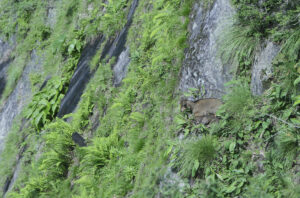
Himalayan goral, resting on a rock ledge, near Sherpagaon, Lower Langtang Valley, central Nepal. (Photo copyright © by Kaj Halberg)
This picture from Delhi Zoo shows the stockiness of the goral. (Photo copyright © by Kaj Halberg)
Nilgiritragus hylocrius Nilgiri tahr
“Still, so tenuous is the existence of this species that one-fourth to one-third of all the Nilgiri tahr in existence were within my view from Anaimudi Peak.”
This quote is from the book Stones of Silence: Journeys in the Himalaya (1980), by German-American biologist and environmentalist George B. Schaller (born 1933). In the 1970s, he estimated that the total population of the Nilgiri tahr might be as low as 1,500 individuals. Since then, conservation measures have caused its numbers to increase to about 3,100. This species is restricted to high altitudes in the southern Western Ghats in Kerala and Tamil Nadu.
Formerly, it was placed in the genus Hemitragus, together with the Himalayan tahr (above) and the Arabian tahr (H. jayakari, today called Arabitragus jayakari). However, genetic research has shown that it is more closely related to sheep of the genus Ovis than to the other tahrs, and, consequently, it was moved to a separate genus.
The last part of the generic name is derived from Ancient Greek tragos (‘goat’), thus ‘the goat from the Nilgiri Hills’. The specific name is likewise from Ancient Greek, from hyle (‘forest’) and Krios, one of the Titans, son of Uranus and Gaia.
Eravikulam National Park, Kerala, where the pictures below were taken, is a stronghold of the Nilgiri tahr, housing an estimated 800-900 individuals, app. one-fourth of the total population.
Nilgiri tahrs. (Photos copyright © by Kaj Halberg)
Nilgiri tahrs, scratching and grooming. (Photo copyright © by Kaj Halberg)
Nilgiri tahr female with a suckling kid. (Photos copyright © by Kaj Halberg)
Nilgiri tahr ‘kindergarten’. (Photo copyright © by Kaj Halberg)
Pseudo-mating, a male mounts another male. (Photos copyright © by Kaj Halberg)
In the late 1990s, tourists began feeding the tahr in Eravikulam, and the animals lost their fear of people. This practice has since been banned. (Photos copyright © by Kaj Halberg)
Pseudois nayaur Bharal, Himalayan blue sheep, Chinese blue sheep
Today, this species is considered the only member of the genus. For many years, it was assumed that an animal living in eastern Tibet and the Sichuan Province was a distinct species, called dwarf blue sheep or dwarf bharal (P. schaeferi). However, genetic research has shown that it is a mere dwarf form of the common bharal.
Today, this species is considered the only member of the genus. For many years, it was assumed that an animal living in eastern Tibet and the Sichuan Province was a distinct species, called dwarf blue sheep or dwarf bharal (P. schaeferi). However, genetic research has shown that it is a mere dwarf form of the common bharal.
The adult ram is a splendid animal, weighing up to 75 kilos, with thick, sweeping horns that may grow to a length of 80 cm. The coat is grey with a bluish sheen (hence its English name), with black markings on chest, flanks, and legs. Ewes and young males are more uniformly grey. The horns of females are small, growing to 20 cm long.
This species is widely distributed in Central Asia, from Ladakh, the northern Himalaya, and the Yunnan Province northwards across Tibet to Gansu, Ningxia, and Inner Mongolia. The Helan Mountains of Ningxia have the highest concentration of bharal in the world, with a population of about 30,000. It is also quite common in parts of the Himalaya, including Ladakh, Dolpo, and the border area between Nepal and Sikkim.
Bharal is the Hindi name of this animal, whereas the Nepali name naur has given rise to the specific name. The generic name is derived from Ancient Greek pseudes (‘false’) and ois (‘sheep’), alluding to the fact that the animal is sheep-like, but also has traits from goats.
The bharal was the main focus of an expedition to the Dolpo area of Nepal in 1973, led by German-American zoologist George Schaller (born 1933). He was accompanied by the famous American writer and environmentalist Peter Matthiessen (1927-2014). Their personal experiences are well documented in Schaller’s book Stones of Silence: Journeys in the Himalaya (1980), and Matthiessen’s The Snow Leopard (1978).
Bharals, illuminated by morning sun, Trisul Nala, Nanda Devi National Park, Kumaon, Uttarakhand. (Photo copyright © by Kaj Halberg)
Bharals, grazing in a semi-desert near Niki La Pass, Ladakh. (Photos copyright © by Kaj Halberg)
Bharals, Ramtang, Upper Ghunsa Valley, eastern Nepal. (Photos copyright © by Kaj Halberg)
My guide Karma Tsering, showing the sweeping horns of a bharal, Ulley, Ladakh. (Photo copyright © by Kaj Halberg)
Tetracerus quadricornis Four-horned antelope, chowsingha
This tiny antelope, the only member of the genus, stands only about 60 cm at the shoulder and weighs about 20 kg. It is the only wild bovid with four horns, of which the anterior pair, in the centre of the skull, is much smaller than the posterior pair.
These horns have given rise all names of this animal. The generic name is from the Greek tetra (‘four’) and keras (‘horn’), whereas the specific name is from the Latin quattuor (‘four’) and cornu (‘horn’). The Hindi name chowsingha is derived from chaar (‘four’) and siing (‘horn’).
Three subspecies have been described, quadricornis, which is distributed in most of the Indian Peninsula, subquadricornutus, which is found in southern India, and iodes, which is restricted to southern Nepal.
Female four-horned antelope, drinking from a waterhole in Sariska National Park, Rajasthan. Note the many bees around the animal. (Photo copyright © by Kaj Halberg)
Female at a waterhole, Sariska National Park. Peafowl (Pavo cristatus) and a crested bunting (Melophus lathami) are also present. (Photo copyright © by Kaj Halberg)
Female at a waterhole, Sariska National Park. The birds are a white-browed fantail (Rhipidura aureola) and a crested bunting (Melophus lathami). (Photo copyright © by Kaj Halberg)
Female with a kid at a waterhole in Sariska National Park. A northern plains langur (Semnopithecus entellus, see below) is seen to the left. (Photo copyright © by Kaj Halberg)
Canidae Dog family
This family, comprising about 35 species, includes domestic dogs, wolves, jackals, hunting dogs, foxes, and many other dog-like animals. About 50 million years ago, a group of carnivores split into two groups, the cat-like Feliformia and the dog-like Caniformia.
The latter evolved into a large number of families, of which the Canidae, about 12 mio. years ago, split into three groups:
Canini includes wolf-like dogs, and South American dogs and foxes.
Vulpini includes typical foxes, bat-eared fox (Otocyon megalotis), and raccoon dog (Nyctereutes procyonoides)
Two foxes of the genus Urocyon seem to have split out at a very early stage (Lindblad-Toh et al. 2005). Modern taxonomists do not include these two species in Canini or Vulpini.
Many species are presented on the page Animals – Mammals: Dog family.
Canis Wolf-like dogs
In later years, following a number of genetic studies, this genus has been the cause of much confusion and has been revised several times. As of 2022, the genus contains between 5 and 11 species. All authorities now recognize 5 species: grey wolf (C. lupus), coyote (C. latrans), African golden wolf (C. lupaster), Ethiopian wolf (C. simensis), and golden jackal (below). Others also regard one or more of the following as separate species: domestic dog (C. familiaris), dingo (C. dingo), red wolf (C. rufus), eastern wolf (C. lycaon), Indian wolf (C. pallipes), and Himalayan wolf (C. himalayensis).
Recently, two species of jackals, the black-backed (formerly C. mesomelas) and the side-striped (formerly C. adustus), have been moved to a separate genus, Lupulella.
Canis aureus Golden jackal
A highly adaptable and successful animal, living in a large variety of habitats. As it often takes domestic fowl and lambs, it is much persecuted, but is nevertheless still expanding its range. Today, 7 subspecies are distributed from Myanmar and Thailand westwards through India, Sri Lanka, the Middle East, and the Arabian Peninsula to the Balkans, Austria, and parts of Germany. Since 2015, several animals have been reported as far north as Denmark.
In north-western India, the ranges of the subspecies aureus and indica overlap.
Golden jackal in morning light, Ranthambhor National Park, Rajasthan. (Photo copyright © by Kaj Halberg)
Golden jackal, drinking from a waterhole, Sariska National Park, Rajasthan. (Photo copyright © by Kaj Halberg)
On an extremely hot April day, this pair of golden jackals enjoy a bath in a waterhole, Sariska National Park. (Photos copyright © by Kaj Halberg)
Cercopithecidae Old World monkeys
This large family, comprising 24 genera and about 140 species, is widely distributed in Africa and Asia. Members include baboons, macaques, colobus monkeys, langurs, and many others. A large number are described on the page Animals – Mammals: Monkeys and apes.
Macaca Macaques
The number of species in this genus has been growing steadily in later years to 23, as two new species have recently been described.
The generic name stems from the word makaku, plural of kaku, a West African Bantu name for a species of mangabey. In Portuguese, makaku became macaco, and in French macaque, the latter adopted by the British. In 1798, French taxonomist Bernard Germain de Lacépède (1756-1825) applied this word of African origin, in the form Macaca, to an almost exclusively Asian group of monkeys, presumably because he was familiar with the Barbary macaque (Macaca sylvanus) – the only species of the group outside Asia, living in north-western Africa and on the Rock of Gibraltar, southern Spain. (Source: itre.cis.upenn.edu/~myl/languagelog/archives/003458.html)
Macaca assamensis Assamese macaque
This monkey is quite similar to the well-known rhesus macaque (below), but has a longer tail, and it lacks the orange hindquarters of that species. It is distributed from western Nepal eastwards to south-western China, and also has populations in Indochina and Bangladesh.
It generally lives in forests at altitudes between 200 and 2,000 m, but may be observed down to sea level in Bangladesh, and it occasionally strays to high mountains, sometimes as high as 4,000 m. It is declining in many places due to hunting and habitat fragmentation.
Members of a troop of about 50 Assamese macaques, observed near Pairo, Lower Langtang Valley, central Nepal. (Photos copyright © by Kaj Halberg)
Macaca mulatta Rhesus monkey
Here we go in a flung festoon,
Half-way up to the jealous moon!
Don’t you envy our pranceful bands?
Don’t you wish you had extra hands?
Wouldn’t you like if your tails were – so –
Curved in the shape of a Cupid’s bow?
Now you’re angry, but – never mind,
Brother, thy tail hangs down behind!
Here we sit in a branchy row,
Thinking of beautiful things we know;
Dreaming of deeds that we mean to do,
All complete, in a minute or two –
Something noble and grand and good,
Won by merely wishing we could.
Now we’re going to – never mind,
Brother, thy tail hangs down behind!
All the talk we ever have heard
Uttered by bat or beast or bird –
Hide or fin or scale or feather –
Jabber it quickly and all together!
Excellent! Wonderful! Once again!
Now we are talking just like men.
Let’s pretend we are – never mind,
Brother, thy tail hangs down behind!
This is the way of the Monkey-kind.
Then join our leaping lines
that scumfish through the pines,
That rocket by where, light and high, the wild-grape swings,
By the rubbish in our wake,
and the noble noise we make,
Be sure, be sure, we’re going to do some splendid things!
Road song by the Bandar-log, from The Jungle Book (1894), by English writer Rudyard Kipling (1865-1936). In Hindi, bandar-log means ‘monkey-people’.
The rhesus monkey is the well-known brown monkey of northern India, in Hindi called bandar. It is found almost everywhere in the country north of the rivers Tapti in Gujarat and Godavari in Maharashtra. The total distribution area stretches from Afghanistan eastwards through Pakistan, India, Nepal, Bangladesh, and the northern part of Myanmar, Thailand, and Laos to Vietnam, and thence northwards to central China.
Its fur is mainly brown, with yellowish-orange hind parts, and the tail is rather short, 20-30 cm. This monkey lives in very diverse habitats, from semi-desert via various forest types to temple groves and cities, from the lowland up to altitudes around 2,500 m.
Following a strong decline due to felling of forest, combined with export of many animals for medical research, the rhesus monkey is now expanding in India, with an estimated population of 500,000 individuals, or more. This expansion is mainly due to the fact that it has adapted to a life in cities.
The size of a territory of a typical troop of rhesus monkeys has been measured at up to 16 km2 in montane forest, and 1-3 km2 in other types of forest, whereas in Kolkata, a troop of 62 individuals was studied, thriving successfully in an area of less than 4 hectares, in the centre of this metropolis.
In some areas, especially in Laos and Vietnam, the species is hunted for food, and habitat destruction has also affected populations locally in Indochina.
In the great Hindu epic Ramayana, the monkey army, led by Hanuman, plays a significant role, and for this reason monkeys are regarded as sacred animals among devout Hindus. Troops of rhesus monkeys, bonnet macaques (below), and northern plains langurs (below) often live around temples, where part of their diet consists of rice, sweets, or other edibles, brought as offerings to the gods.
Examples of such temples are Pashupatinath, a Hindu temple on the shores of the Bagmati River, Kathmandu, the Manakamana Kali Temple in central Nepal, and the great Buddhist stupa Swayambhunath in Kathmandu, which also contains Hindu shrines.
The role of the monkey army in Ramayana is described on the page Animals – Mammals: Monkeys and apes.
In the West, the rhesus monkey has become well-known due to its usage in medical research, which detected the rhesus factor, an inherited antigen in the blood of humans.
The specific name is of unknown origin. The common name may refer to a person in Greek mythology, King Rhesus of Thrace, who sided with the Trojans during the Trojan War, related in the Iliad.
The fur on the rear part of the rhesus monkey is yellowish-orange. This one has found a garland of marigold flowers, Varanasi, Uttar Pradesh. (Photo copyright © by Kaj Halberg)
The behind of rhesus monkeys is reddish with two bare patches of skin that the animal sits on. – Swayambhunath, Kathmandu. (Photo copyright © by Kaj Halberg)
Rhesus monkey, Varanasi. (Photo copyright © by Kaj Halberg)
Rhesus monkeys, resting on a chorten (a Tibetan Buddhist shrine, similar to a stupa), Swayambhunath. (Photo copyright © by Kaj Halberg)
Clinging to a clothes-line, this one is looking through a window, Varanasi. (Photo copyright © by Kaj Halberg)
This one is walking along a narrow wall, surrounding the Hawa Mahal Palace, Jaipur, Rajasthan. (Photo copyright © by Kaj Halberg)
This rhesus monkey is enjoying the morning sun, sprawled on a tree branch, where it spent the previous night, Uttarkashi, Garhwal, Uttarakhand. (Photo copyright © by Kaj Halberg)
Rhesus monkeys are true acrobats, sometimes walking on wires from one building to the next, or even hanging upside down. – Haridwar, Uttarakhand (top), and Swayambhunath. (Photos copyright © by Kaj Halberg)
Female rhesus monkeys are affectionate mothers. These were photographed at the Manakamana Kali Temple (top), and at Swayambhunath. (Photos copyright © by Kaj Halberg)
Rhesus monkeys spend a considerable time grooming. – Swayambhunath (top), and Pashupatinath, Kathmandu. (Photos copyright © by Kaj Halberg)
Copulating rhesus monkeys, Swayambhunath. (Photo copyright © by Kaj Halberg)
Females and young on a wall near the Ganges River, Varanasi. (Photos copyright © by Kaj Halberg)
This young rhesus monkey jumps from one wall to another, Varanasi. (Photo copyright © by Kaj Halberg)
Rhesus monkeys, eating offerings of rice, Manakamana Kali Temple, central Nepal (top), and Swayambhunath. (Photos copyright © by Kaj Halberg)
Rhesus monkeys, gnawing banana peels, Varanasi. (Photos copyright © by Kaj Halberg)
These rhesus monkeys are eating biscuits, presented by a tourist, Manakamana Kali Temple. (Photos copyright © by Kaj Halberg)
This young monkey is eating a piece of water melon, Varanasi. (Photo copyright © by Kaj Halberg)
One day, when I had visited the Swayambhunath Stupa, I was descending the staircase, when I heard a strange sound behind me. Turning around, I saw an empty Tuborg beer can come tumbling down the stairs, pass me, and come to a stop just in front of a rhesus monkey. The monkey grabbed the can, sniffed it, and then quickly dropped it, baring its teeth as if to say, “This stuff is not for me!”
(Photos copyright © by Kaj Halberg)
A street entertainer with performing rhesus monkeys, Delhi. (Photo copyright © by Kaj Halberg)
Macaca radiata Bonnet macaque
This macaque is restricted to the southern half of India, replacing the rhesus monkey south of the Tapti and Godavari Rivers. It is a little smaller than the rhesus monkey, its fur is greyish-brown, paler on the belly. It has an extremely long tail, longer than the body. On its crown is a cowlick, resembling a bonnet. The specific name also refers to the cowlick.
It is very common, locally abundant, living in all forest types, scrubland, plantations, agricultural lands, and urban areas. It is usually found below 2,000 m altitude, occasionally up to 2,600 m. As it often feeds in agricultural areas, conflicts with humans is an increasing problem. It is locally hunted, and many are caught for research, as well as for street performing.
Whereas the temple monkeys in northern India are mainly rhesus monkeys, this role is taken over by bonnet macaques in southern Indian temples.
The bonnet macaque has a very long tail, longer than the body. This one, resting on a cornice in the Sri Minakshi Temple, Madurai, Tamil Nadu, is licking on a discarded drinking straw. (Photo copyright © by Kaj Halberg)
Male bonnet macaque, resting in a growth of bamboo, Periyar National Park, Kerala. (Photo copyright © by Kaj Halberg)
This bonnet macaque in Honnevara Forest, Karnataka, is trying to decide, whether I am dangerous or not. (Photo copyright © by Kaj Halberg)
Female bonnet macaques are loving mothers. This one with a tiny young was observed at Azhiyar Ghat, Tamil Nadu. (Photos copyright © by Kaj Halberg)
This one at Singhur Ghat, Nilgiri Mountains, Tamil Nadu, is feeding on acacia seeds. (Photo copyright © by Kaj Halberg)
Sitting on our car, this one is gnawing on a banana peel, afterwards looking at its own reflection in the rear window. – Azhiyar Ghat. (Photos copyright © by Kaj Halberg)
This bonnet macaque is washing food in the Theppakadu River, Mudumalai Tiger Reserve, Tamil Nadu, before eating it. (Photo copyright © by Kaj Halberg)
A large troop of bonnet macaques live around the famous Hindu cave temples in the city of Badami, Karnataka. In this picture, several females and a young huddle together to keep warm in the morning cold. (Photo copyright © by Kaj Halberg)
Three females, one with a tiny young, Badami. (Photos copyright © by Kaj Halberg)
This female is grooming another monkey, presumably its young, Badami. (Photo copyright © by Kaj Halberg)
Young bonnet macaque, enjoying the evening sun, Badami. (Photo copyright © by Kaj Halberg)
Like most other macaques, bonnet macaques love bathing, as these young ones in the Theppakadu River, Mudumalai Tiger Reserve, Tamil Nadu. After the bath, their ‘bonnet’ looks rather punky. (Photos copyright © by Kaj Halberg)
This bonnet macaque is crossing a heavily trafficked road in Badami by balancing on an electric wire, using its long tail as counter-balance. (Photo copyright © by Kaj Halberg)
At temples, food is always plentiful, and as the monkeys don’t move much around, they often become obese, like this one, observed in the Sri Minakshi Temple, Madurai, Tamil Nadu. (Photo copyright © by Kaj Halberg)
Macaques, which live near humans, often become scavengers, like this bonnet macaque in Periyar National Park, Kerala. (Photo copyright © by Kaj Halberg)
This street entertainer in the city of Tirumalai, Andhra Pradesh, has caught two young bonnet macaques, which he is going to train to perform. They seem to be arguing about something. (Photo copyright © by Kaj Halberg)
This relief in a Jain temple atop the rock Vindyagiri, Sravanabelagola, Karnataka, depicts a bonnet macaque, embracing a jackfruit (Artocarpus heterophyllus). (Photo copyright © by Kaj Halberg)
Macaca silenus Lion-tailed macaque
This macaque is unique, as both male and female have a huge greyish mane around the head, which has given rise to its German name, Bartaffe (‘bearded monkey’). Apart from the mane, the fur is jet-black. The English name stems from another characteristic of this animal: the tuft at the end of the tail.
The lion-tailed macaque is endemic to rainforests of the southern part of the Western Ghats, in Karnataka, Kerala, and Tamil Nadu. Although it is distributed in a huge area, the factual area of occupancy is small, as its habitat has been severely fragmented due to establishment of agricultural areas and plantations of tea, coffee, cardamom, and eucalyptus.
The total population of this animal is estimated at less than 4,000 individuals, made up of 47 isolated sub-populations. In one location, the Kodagu District, Karnataka, the species was formerly highly threatened by hunting for food. In later years, the population seems to have become stabilized due to better protection measures.
The specific name is a Latinized version of Ancient Greek Seilenos, in Greek mythology tutor of the wine god Dionysus.
The pictures below are all from the Puthutottam Forest, Tamil Nadu, where a troop of lion-tailed macaques have become accustomed to people, as they are often being fed by tourists.
Lion-tailed macaques on the road through Puthutottam Forest, Tamil Nadu. (Photos copyright © by Kaj Halberg)
This male is baring his huge canines, but he is probably just yawning, as this species is not at all aggressive towards people. (Photo copyright © by Kaj Halberg)
Female with a young. (Photo copyright © by Kaj Halberg)
This lion-tailed macaque is lying on the road, eating tiny pebbles, which make loud crunching noises between its teeth! (Photo copyright © by Kaj Halberg)
Lion-tailed macaque in its true habitat: rainforest. (Photos copyright © by Kaj Halberg)
Macaca sinica Toque macaque
This reddish-brown monkey resembles the bonnet macaque, but the cowlick is further forward on its crown. It is restricted to Sri Lanka, where 3 subspecies are recognized, sinica in the dry zone of the eastern and northern parts of the island, aurifrons in the south-western lowland rainforest zone, and opisthomelas in the central highland wet zone.
It lives in a variety of forest types, from sea level up to about 2,100 m. The distribution areas of all three subspecies are very fragmented, and opisthomelas is restricted to an area of less than 500 km2, with only a fifth of this area actually occupied by the animals. The chief threat to this species is habitat loss due to establishment of plantations and agricultural lands. Many are shot, as they are doing considerable damage to crops.
The toque macaque is still widely distributed, but the population may have declined by more than 50% since 1975.
The specific name is Latin, meaning ‘from China’. When Swedish naturalist Carl Linnaeus (1707-1778) named the species in 1771, he must have been misinformed about the origin of it. The common name is a kind of hat without brim.
The dry-zone race of the toque macaque, sinica, is found in the eastern and northern parts of Sri Lanka. This one was photographed at Polonnaruwa. (Photo copyright © by Kaj Halberg)
Young toque macaque, sitting between stilt roots of a banyan fig (Ficus benghalensis), Sigiriya, eastern Sri Lanka. (Photo copyright © by Kaj Halberg)
This young toque macaque at Polonnaruwa is drinking by dipping its hand into a puddle inside a hollow tree trunk, whereupon it licks its hand. (Photo copyright © by Kaj Halberg)
Subspecies aurifrons is distributed in the south-western lowland rainforest zone. This one was observed in Sinharaja Forest Reserve. (Photo copyright © by Kaj Halberg)
Semnopithecus Typical langurs
This genus of leaf-eating monkeys contains about 8 species, all restricted to the Indian Subcontinent. In the past, all grey langurs living here were regarded as belonging to a single species, S. entellus, divided into six subspecies. However, recent morphological studies, combined with DNA-analyses, suggest that the grey langurs should be regarded as 6 full species: northern plains langur (S. entellus), terai langur (S. hector), pale-armed langur (S. schistaceus), Kashmir langur (S. ajax), black-footed langur (S. hypoleucos), and tufted langur (S. priam). A seventh species, dussumieri, has been declared conspecific with northern plains langur.
Today, most authorities consider all langurs on the Indian Subcontinent as belonging to the this genus. Formerly, two species, the Nilgiri langur (S. johnii) of south-western India, and the purple-faced langur (S. vetulus) of Sri Lanka, were regarded as members of the genus Trachypithecus (below),which is today considered to be distributed only in north-eastern India, Bhutan, and Southeast Asia.
The generic name is from the Greek semnos (‘sacred’) and pithekos (‘monkey’), alluding to the sanctity of monkeys to Hindus. The role of the langur in the great Hindu epic Ramayana is described on the page Animals – Mammals: Monkeys and apes.
Semnopithecus entellus Northern plains langur
This speciesis widespread in northern, central, and south-central India, from Rajasthan, Uttar Pradesh, and West Bengal southwards to Telangana and northern Karnataka and Kerala, with a small population in western Bangladesh, which probably originated from a single pair, introduced by Hindu pilgrims on the bank of the Jalangi River.
It is quite common, living in a variety of habitats, including forests, scrubland, temple groves, gardens, and towns, up to an altitude of c. 1,700 m. It is locally threatened by habitat loss due to intensified agriculture and fires, and by hunting for food by newly settled people in Andhra Pradesh and Orissa.
Previously, western and southern populations of this species were regarded as a separate species, the southern plains langur (S. dussumieri), but recent genetic research has declared this name invalid.
The specific name refers to an aged Trojan, mentioned in the poem The Aeneid, by Roman poet Publius Vergilius Maro (70-19 B.C.), also known as Virgil. The Aeneid relates the legendary story of Aeneas, a Trojan who fled after the fall of Troy to Italy, where he became the ancestor of the Romans.
Northern plains langurs in morning sun, Sariska National Park, Rajasthan. This species usually carries its tail arched over its back. (Photo copyright © by Kaj Halberg)
Northern plains langurs, drinking from a waterhole, Sariska National Park. Note the many bees in the bottom picture. (Photos copyright © by Kaj Halberg)
Troop of northern plains langurs, resting on a rock outside the sacred Udayagiri Caves, near Bhubaneswar, Odisha. (Photos copyright © by Kaj Halberg)
This female outside the Udayagiri Caves has a tiny young. (Photo copyright © by Kaj Halberg)
Resting male, Ranthambhor National Park, Rajasthan. (Photo copyright © by Kaj Halberg)
This male is baring his teeth as a sign of aggression, Sariska National Park. (Photo copyright © by Kaj Halberg)
Pseudo-mating young, Sariska National Park. (Photo copyright © by Kaj Halberg)
In many places, the northern plains langurs have adapted to a life in cities, where they often become a menace, stealing fruit or other edibles that are not guarded. Their status as sacred animals ensure that they are not harmed, despite their impudence. They are also common around temples, where they feed on rice and other edibles, brought by devout Hindus as offerings to the gods.
These northern plains langurs are sitting on a roof top in the town of Pushkar, Rajasthan, from where they, like a bunch of street urchins, survey the surroundings for fruit or other edibles to steal. (Photo copyright © by Kaj Halberg)
Northern plains langurs, resting in a pavilion near the sacred lake in Pushkar. (Photo copyright © by Kaj Halberg)
This one is resting on a sculpture, depicting the bull Nandi, mount of the great Hindu god Shiva, Chittorgarh Fort, Rajasthan. (Photo copyright © by Kaj Halberg)
A Hindu legend relates that a young man named Narad Muni went to participate in a Swayamwara, during which young girls can choose a husband. This young man was very proud of himself and was convinced that he was the most handsome among the men. However, as the day came to an end, he went away heartbroken, because none of the young girls had chosen him. On his way home, he got thirsty, so he went to a waterhole to quench his thirst. His reflection in the water told him that he now had a monkey’s head.
”His reflection in the water told him that he now had a monkey’s head.” – Sariska National Park. (Photo copyright © by Kaj Halberg)
Semnopithecus hector Terai langur
This species is found in the Himalayan foothills, the terai, encountered up to an altitude of about 1,600 m, from Uttarakhand eastwards to south-western Bhutan. It mainly lives in forests, occasionally feeding in orchards and fields with crops. Its fur is thicker than that of the northern plains langur (above), but not as rich as that of the pale-armed langur (below).
The total number of terai langurs is probably only about 10,000 mature individuals, and the population is slowly declining, mainly due to habitat loss.
The specific name refers to a person in Greek mythology, Prince Hector of Troy, who was one of the foremost fighters among the Trojans during the Trojan War, related in the Iliad.
During an excursion with my Indian friend Ajai Saxena to Rishikesh, Uttarakhand, we had company of a couple of terai langurs, which took their seat on the roof of our car. Presumably, many car drivers feed these monkeys, but as we oppose the habit of feeding wild animals, we didn’t give them anything, and shortly after they disappeared, jumping into the trees. (Photos copyright © by Kaj Halberg)
Semnopithecus hypoleucos Black-footed langur
This monkey has jet-black hands and feet, contrasting sharply with its grey arms and legs. It occurs in the Western Ghats, from Goa southwards through Karnataka to Kerala. In some areas, it is seriously threatened by hunting, and it has already been extirpated from parts of the Brahmagiri Hills in Kodagu District, Karnataka.
Some authorities believe that the black-footed langur is a natural hybrid between the northern plains langur (above) and the Nilgiri langur (below), and others regard it as a subspecies of the former.
The specific name is derived from Ancient Greek hypo (‘beneath’) and leukos (‘white’), alluding to the whitish belly of this species.
The black-footed langur has jet-black hands and feet, contrasting sharply with its grey arms and legs. – Dandeli Wildlife Sanctuary, Karnataka. (Photo copyright © by Kaj Halberg)
Black-footed langur, eating leaves, Dandeli Wildlife Sanctuary. (Photo copyright © by Kaj Halberg)
This one in Anshi National Park, Karnataka, is busy scratching itself. (Photo copyright © by Kaj Halberg)
This one is climbing up a dead bamboo stem, from which it jumps onto another one, Anshi National Park. (Photos copyright © by Kaj Halberg)
Black-footed langur, eating flower buds of a silk-cotton tree (Bombax ceiba), Honnavar Forest, Karnataka. (Photo copyright © by Kaj Halberg)
Semnopithecus johnii Nilgiri langur
This species is jet-black, with pale-brown fur on the crown and on a ruff around its face. It is restricted to the Western Ghats in Karnataka, Kerala, and Tamil Nadu, where it lives in forests at elevations between 300 and 2,000 m.
Formerly, it was threatened by habitat loss due to mining, dams, and human settlement, and by hunting, but the latter has decreased in recent years due to better protection, and after the introduction of the Indian Wildlife Protection Act in 1972, the population has increased. Since the 1990s, it has been relatively stable, counting around 20,000 individuals.
Previously, this species was placed in the genus Trachypithecus (below).
The specific name honours German missionary and naturalist Christoph Samuel John (1747-1813), who worked for the Danish-Halle Mission in the Danish settlement of Tranquebar, Tamil Nadu, today known as Tarangambadi.
Nilgiri langurs, eating leaf buds, Periyar National Park, Kerala. (Photos copyright © by Kaj Halberg)
Nilgiri langur, Eravikulam National Park, Kerala. (Photo copyright © by Kaj Halberg)
Semnopithecus priam Tufted langur
Two subspecies of this monkey are recognized, priam, which occurs in several disjunct populations, from the southern shores of the Krishna River, Andhra Pradesh, southwards to the city of Madurai, Tamil Nadu, whereas subspecies thersites is found in parts of the Western Ghats, and in the dry zone of Sri Lanka. The affinity of some South Indian populations is not known, as they have been very poorly studied. Genetic research indicates that there are consistent differences between the two taxa, and maybe they will be split into two separate species in the future.
The tufted langur lives in forests, temple groves, gardens, and cultivated areas, in India up to altitudes around 1,200 m, in Sri Lanka up to about 500 m.
The specific name refers to Priam, in Greek mythology the legendary last king of Troy during the Trojan War.
Tufted langurs, subspecies priam, Mudumalai Tiger Reserve, Tamil Nadu. (Photo copyright © by Kaj Halberg)
Tufted langurs, seen as silhoettes against the light, Mudumalai Tiger Reserve. (Photo copyright © by Kaj Halberg)
Tufted langur, Masinagudi, Mudumalai Tiger Reserve. Spotted deer (Axis axis) are seen in the background. (Photo copyright © by Kaj Halberg)
Tufted langur, Masinagudi. (Photo copyright © by Kaj Halberg)
This male is baring his teeth as a sign of aggression, Masinagudi. (Photo copyright © by Kaj Halberg)
Tufted langur, running full speed along a road, Mudumalai Tiger Reserve. (Photo copyright © by Kaj Halberg)
Tufted langur, ssp. thersites, Polonnaruwa, Sri Lanka. (Photos copyright © by Kaj Halberg)
Tufted langurs, Anuradhapura , Sri Lanka. (Photos copyright © by Kaj Halberg)
This is probably a hybrid between tufted langur and Nilgiri langur (above), Annamalai National Park, Tamil Nadu. (Photo copyright © by Kaj Halberg)
Semnopithecus schistaceus Pale-armed langur, Nepal langur
This species is easily identified by its luxurious, pale grey fur and the large white ruff around its jet-black face. It has a wide distribution at mid-elevations in the Himalaya, mostly between 1,500 and 3,500 m, but occasionally up to 4,000 m, from Pakistan through India and Nepal to Bhutan and extreme south-eastern Tibet.
It mainly lives in lush monsoon forests, occasionally found in scrubland and agricultural areas. It is quite common, and the population is fairly stable. Threats include habitat loss through logging, fire, and human encroachment, and it is hunted in Tibet for usage in traditional medicine.
The specific name is derived from Latin, meaning ‘slate-coloured’ – very pale slate, one must say!
Part of a large troop of pale-armed langurs, resting and playing in a meadow, Ghora Tabela, Upper Langtang Valley, central Nepal. (Photos copyright © by Kaj Halberg)
Pale-armed langurs, resting on a stone wall, Kuldi Ghar, Modi Khola Valley, Annapurna, central Nepal. (Photo copyright © by Kaj Halberg)
Male pale-armed langur, resting in a tree, Tadapani, Annapurna, central Nepal. (Photo copyright © by Kaj Halberg)
Pale-armed langurs, Dodi Tal Lake, Upper Asi Ganga Valley, Garhwal, Uttarakhand. (Photos copyright © by Kaj Halberg)
This one is feeding on buds and flowers of Viburnum grandiflorum, Dodi Tal. (Photo copyright © by Kaj Halberg)
Troop of pale-armed langurs, eating soil to obtain minerals, Banthanti, Annapurna, central Nepal. (Photo copyright © by Kaj Halberg)
Semnopithecus vetulus Purple-faced langur
Four subspecies of this langur are recognized, all restricted to Sri Lanka.
The nominate vetulus lives in an area of less than 5,000 km2 of rainforest in south-western Sri Lanka, up to an altitude of around 1,000 m. Where its natural habitat has been destroyed, it may live in gardens and plantations, but these habitats offer no long-term survival prospects for it. Subspecies nestor lives in a similar habitat, further north than vetulus, whereas philbricki is found in moister forests of the dry zone. Subspecies monticola is restricted to the montane forests of central Sri Lanka, at elevations between 1,000 and 2,200 m.
All four subspecies are endangered, as they are believed to have undergone a decline of more than 50% in the last 40 years due to habitat loss and hunting.
The specific name is Latin, meaning ‘old’. It probably refers to the large whitish beard of this otherwise dark monkey.
Like the Nilgiri langur (above), the purple-faced langur was formerly placed in the genus Trachypithecus.
Portrait of a captive lowland purple-faced langur, of subspecies vetulus or nestor, Sri Lanka. (Photo copyright © by Kaj Halberg)
The dry-zone subspecies of the purple-faced langur, philbricki, is found in forests of moister areas of the dry zone of Sri Lanka. These pictures are from Polonnaruwa. (Photos copyright © by Kaj Halberg)
Trachypithecus Lutungs
This genus, encompassing 15 species, is distributed from Bhutan and north-eastern India eastwards to the southernmost parts of China, and thence southwards through Southeast Asia to the Indonesian islands Java, Bali, and Lombok.
This genus, counting 15 species, is distributed from Bhutan and north-eastern India eastwards to the southernmost parts of China, and thence southwards through Indochina to Java, Bali, and Lombok.
The generic name is derived from the Greek trach (‘rough’) and pithekos (‘monkey’), referring to the dense fur of some species in the genus.
Trachypithecus geei Golden langur
This species occurs only in Bhutan and adjacent parts of Assam, between the rivers Manas in the east and Sankosh in the west. It lives in forests along the foothills of the Himalaya up to elevations around 3,000 m.
Its total known range is less than 30,000 km2, and much of it is not suitable habitat. The estimated population is less than 1,200 individuals in India and around 4,000 in Bhutan. It has declined by more than 30% in the last 30 years and is expected to decline further due to habitat loss. The population in India is highly fragmented, with the southern population completely separated from northern populations due to the effects of human activities.
The population in Manas National Park, Assam, is threatened by hybridization with a close relative, the capped langur (T. pileatus). Formerly, these two species were separated by rivers, but a number of constructed bridges has now made it easy for them to cross these rivers.
The golden langur was described as late as 1956, but was known much earlier by naturalists, the earliest record being by R.B. Pemberton in a paper from 1838, Report on Bootan Indian Studies Past and Present. However, his work was lost and not rediscovered until the 1970s, and the golden langur was not mentioned again until 1907, when E.O. Shebbeare reported seeing a ’cream-coloured langur’ in the vicinity of Jamduar.
In 1919, a publication stated that a pale yellow-coloured langur was common in a district near Goalpara in Assam, and in 1947, C. G. Baron wrote: ”I saw some white monkeys (…) and, as far as I know, they are an undescribed species. Their entire body and tail are of the same colour – pale silver-golden, not unlike a blonde.”
A number of other sightings roused the interest of celebrated naturalist Edward Pritchard Gee (1904-1968), who observed and photographed three troops of golden langurs in 1953. He reported his results to the Zoological Survey of India, and in 1955 six specimens were collected. The species was described by Dr. H. Khajuria, who named it Presbystis gee, in honour of Mr. Gee.
Golden langurs, Manas National Park, Assam. (Photos copyright © by Kaj Halberg)
Cervidae Deer
These animals differ from other ruminants by possessing antlers, which are shed every year. The family contains 20 genera with about 90 species. Many species are presented on the page Animals – Mammals: Deer.
Deer live in almost all types of habitats, ranging from tundra to tropical rainforest. They are widely distributed, with native species present in all continents, except Antarctica and Australia. In Africa, however, only a single species is present in the Atlas Mountains. The largest concentration of species is found in Asia.
A larger deer male is called a stag, a female a hind, and a young a kid or a calf. A smaller deer male is called a buck, a female a doe, a young a fawn.
Axis
Previously, the hog deer (Hyelaphus porcinus, below) and three other small deer were placed in this genus. However, genetic studies have revealed that they differ sufficiently from the spotted deer (below) to constitute a separate genus, leaving the latter as the only member of the genus.
Axis axis Spotted deer, chital
This beautiful deer is native to the Indian Subcontinent, including Sri Lanka, but is found nowhere else. It is fairly common in most of the distribution area, though declining in places due to habitat destruction. It has been introduced elsewhere, including Australia, the United States, and several South American countries.
A medium-sized deer, males may weigh up to 100 kg, whereas the females are much lighter.
The generic and specific names are Latin, referring to an Indian animal, mentioned by Roman philosopher and naturalist Pliny the Elder (c. 23-79 A.D.). The Hindi name chital is derived from Sanskrit citrala (‘spotted’).
Spotted deer stag, drinking from a waterhole in Sariska National Park, Rajasthan. A rufous treepie (Dendrocitta vagabunda) is sitting on its back. To the left a peacock (Pavo cristatus). (Photo copyright © by Kaj Halberg)
Resting spotted deer stag, with antlers in velvet, Ranthambhor National Park, Rajasthan. (Photo copyright © by Kaj Halberg)
This hind with a kid is raising her tail as an alarm signal, Sariska National Park. (Photo copyright © by Kaj Halberg)
When approaching these spotted deer in Mudumalai Tiger Reserve, Tamil Nadu, I stepped on a dead branch. The sound immediately made them raise their heads and stare in my direction. (Photo copyright © by Kaj Halberg)
Spotted deer in grassland, Corbett National Park, Uttarakhand. (Photos copyright © by Kaj Halberg)
We found this abandoned kid in the grassland of Corbett National Park. (Photo copyright © by Kaj Halberg)
On a baking hot summer day, spotted deer quench their thirst in a waterhole, Sariska National Park. The palms in the background are Indian date palms (Phoenix sylvestris). A peahen (Pavo cristatus) is seen in the lower picture. (Photos copyright © by Kaj Halberg)
This stag was killed by a tiger or a leopard, but was left due to heavy rain, Corbett National Park. (Photo copyright © by Kaj Halberg)
Cervus
Genetic research indicates that this genus evolved in Central Asia, where an ancient species, now named Cervus hanglu, still exists, with 3 subspecies, the Kashmir stag (below), the Bactrian deer, ssp. bactrianus, which is widespread in Central Asia, and the Yarkand deer, ssp. yarkandensis, which is restricted to Xinjiang. About 7 million years ago, the climate became cooler, causing this ancestral deer to migrate north, east, and west.
Today, the western Eurasian group, called red deer (C. elaphus), has several subspecies in western Europe, the Balkans, the Middle East, and North Africa. However, the taxonomy of this group remains unsettled, and some subspecies may merit specific status, including C. (e.) corsicanus, which lives on Corsica and Sardinia. It may be conspecific with the Barbary stag (C. (e.) barbarus) of north-western Africa.
The eastern Eurasian group includes the wapiti (C. canadensis), which is distributed in north-eastern Asia and North America, Thorold’s or white-lipped deer (C. albirostris), which occurs in eastern Tibet, Qinghai, Gansu, Sichuan, and north-western Yunnan, and the sika deer (C. nippon), which is found in Japan and Taiwan, at scattered locations in eastern China, and in Ussuriland, south-eastern Siberia.
Some authorities place several South Asian deer in the genus Cervus, others in the genus Rusa, including the sambar deer (below) and the rusa deer (C. timorensis or R. timorensis).
The generic name is the classical Latin term for deer.
Cervus hanglu ssp. hanglu Kashmir stag
Traditionally, this deer was regarded as a subspecies of C. elaphus. However, recent genetic studies have concluded that it belongs to an ancient lineage (see genus above).
It is restricted to a few locations in Kashmir and northern Himachal Pradesh. Habitat destruction, competition from grazing livestock, and poaching brought it to the brink of extinction, with only about 150 individuals surviving around 1970. Conservation measures has had the effect that the population is now around 300, but this number is still dangerously low.
The specific name is a corruption of hangul, the local Kashmir name of this deer.
This picture is from the interesting Hindu temple Hadimba in Manali, Himachal Pradesh, which is adorned with various items, including antlers of Kashmir stag, ringed horns of Siberian ibex (Capa sibirica, see above), and smooth horns of bharal (Pseudois nayaur, see above). The history behind this temple is described on the page Religion: Hinduism. (Photo copyright © by Kaj Halberg)
Cervus unicolor Sambar deer
This very large deer, by some authorities named Rusa unicolor, has a wide distribution in Asia, from the entire Indian Subcontinent eastwards to southern China and Taiwan, , and thence southwards through Indochina and Malaysia to Sumatra and Borneo.
The weight of a stag is typically around 350 kg, although large specimens may weigh as much as 550 kg. Hinds are smaller, weighing 100-200 kg. Populations of this deer have declined substantially in most areas, mainly due to hunting and habitat destruction. It has been introduced to various countries around the world, including Australia, New Zealand, and the United States.
The common name is derived from Sanskrit sambara (‘deer’).
Sambar stags, one with the antlers in velvet, Maha Eliya Thenna (Horton Plains) National Park, Sri Lanka. Subspecies unicolor, found in India and Sri Lanka, is the largest of the 7 accepted subspecies. (Photos copyright © by Kaj Halberg)
Sambar stag, Ranthambhor National Park, Rajasthan. (Photo copyright © by Kaj Halberg)
This stag, observed in Ranthambhor National Park, has had a close encounter with a tiger or a leopard, evident from the scar on the flank. (Photo copyright © by Kaj Halberg)
Sambar deer ofte feed in the lakes of Ranthambhor National Park. This herd is resting in front of ruins of a former Rajput palace. The fierce Rajputs are described on the page Travel episodes – India 1986: “His name is Muhammad!” (Photo copyright © by Kaj Halberg)
Sambar stag, drinking from a lake, Ranthambhor National Park. It is raising its tail as an alarm signal. (Photo copyright © by Kaj Halberg)
Sambar deer in morning light, Sariska National Park, Rajasthan. (Photo copyright © by Kaj Halberg)
Hind in evening sun, Sariska National Park. (Photo copyright © by Kaj Halberg)
Portrait of a hind, which is much bothered by flies, Ranthambhor National Park. (Photo copyright © by Kaj Halberg)
Calf, reflected in a lake, Ranthambhor National Park. (Photo copyright © by Kaj Halberg)
Suckling calf, Ranthambhor National Park. (Photo copyright © by Kaj Halberg)
Sambar deer, grazing on succulent water plants in a lake, Ranthambhor National Park. (Photos copyright © by Kaj Halberg)
This hind is feeding in a swamp in Keoladeo National Park, Rajasthan. Painted storks (Mycteria leucocephala) are nesting in the tree in the background. One of the storks is spreading its wings like two large fans. (Photo copyright © by Kaj Halberg)
A hind and her calf quenches their thirst at a waterhole, Sariska National Park. The monkeys to the right are northern plains langurs (see above). (Photo copyright © by Kaj Halberg)
A rufous treepie (Dendrocitta vagabunda) is using the back of this hind as a lookout post, Sariska National Park. (Photo copyright © by Kaj Halberg)
Drinking hinds, Sariska National Park. (Photos copyright © by Kaj Halberg)
On a hot September day, this hind is cooling down in a waterhole, Sariska National Park. Peafowl (Pavo cristatus) are seen in the background. (Photo copyright © by Kaj Halberg)
Stag, enjoying a bath, Sariska National Park. (Photo copyright © by Kaj Halberg)
Hyelaphus
Previously, the Indian hog deer (below) and three other small Asian deer were placed in the genus Axis (above). However, genetic studies have revealed that they differ sufficiently from the spotted deer (above) to constitute a separate genus.
I have not been able to find an explanation regarding the etymology of the generic name. The last part is a Latinized version of Ancient Greek elaphos (‘deer’), and the first part may be derived from Ancient Greek hyle (‘forest’).
Hyelaphus porcinus Indian hog deer
A small deer, the buck standing about 70 cm at the shoulder and weighing about 50 kg. The doe is much smaller, standing about 60 cm and weighing c. 30 kg.
It ranges from Pakistan in a belt eastwards across the Gangetic Plain of northern India to Bangladesh and Myanmar. It has also been introduced to Australia and Sri Lanka. In Indochina and south-western China, it is replaced by the Indochinese hog deer (H. annamiticus).
The specific name, from Ancient Greek porkos (‘pig’ or ‘hog’), was given in allusion to the hog-like manner, in which it runs through the forest, with the head stretched forward, so that it can duck under obstacles instead of leaping over them.
Hog deer and a single spotted deer (see above), eating soil to obtain minerals, Rapti River, southern Nepal. (Photos copyright © by Kaj Halberg)
Hog deer buck, his antlers in velvet, Rapti River. (Photo copyright © by Kaj Halberg)
Hog deer does, Kaziranga National Park, Assam (top), and Corbett National Park, Uttarakhand. (Photos copyright © by Kaj Halberg)
Hog deer, drinking from a rainwater puddle, Corbett National Park. (Photo copyright © by Kaj Halberg)
Muntiacus Muntjac, barking deer
This genus of small deer, comprising 12 species, is native to Asia, occurring from India and Sri Lanka eastwards to southern China and Taiwan, and thence southwards to the Indonesian Archipelago.
Males are characterized by their short antlers, often only about 10 cm long. Instead of using their antlers, they tend to fight for territory with their 2-4 cm long upper canines. Where the males have antlers, the females have small bony knobs with tufts of fur.
The generic name is a Latinized form of the Dutch name of these animals, muntjak, which is a corruption of their Sundanese name, mencek. The popular name barking deer was given in allusion to their alarm call, which is reminiscent of a dog’s barking.
Muntiacus muntjak Indian muntjac
This very widespread animal, in Hindi known as kakar, is distributed from India and Sri Lanka eastwards to southern China, and thence southwards through Indochina and Malaysia to Java and Bali. 15 subspecies have been described. In the Himalaya, it is found up to elevations around 2,500 m.
Indian muntjac buck with antlers in velvet, between Sherpagaon and Surkhe, Lower Langtang Valley, central Nepal. (Photo copyright © by Kaj Halberg)
Indian muntjac doe in dense vegetation, Begnas Tal, central Nepal. (Photo copyright © by Kaj Halberg)
Does, Corbett National Park, Uttarakhand. (Photos copyright © by Kaj Halberg)
Indian muntjac in captivity, Melamchi Phul, Helambu, central Nepal. (Photo copyright © by Kaj Halberg)
Rucervus
This genus is an ancient lineage that, together with the genus Axis (above), represents the oldest radiation in the subfamily Cervinae. It was originally proposed as a subgenus of Cervus by British naturalist and ethnologist Brian Hodgson (1801-1894), based on antler shape. Today, the genus has a single member, the barasingha (below), as the only other member, Schomburgk’s deer (R. schomburgki) of Indochina, is probably extinct.
The generic name is a combination of two other genus names, Rusa, which means ‘deer’ in Malay, and Cervus (above).
Rucervus duvaucelii Barasingha, swamp deer
In the 1800s, this species ranged from Pakistan eastwards across northern and central India and southern Nepal to Bangladesh and north-eastern India. However, due to uncontrolled hunting and habitat loss, the population is today highly fragmented, with scattered herds found in southern Nepal and in Uttar Pradesh, Assam, and Madhya Pradesh. It is extinct in Pakistan and Bangladesh.
This deer differs from all other Indian species in that the antlers carry more than 3 tines, giving rise to the Hindi name barah singga, meaning ‘twelve-horned’. Mature stags usually have 10-14 tines, but up to 20 has been recorded.
Three subspecies have been described. The western nominate race has splayed hooves, an adaptation to live in flooded grasslands in the Indo-Gangetic plain. Today, a population of about 2,000 live in scattered locations in Uttar Pradesh, and about 2,200 in the Sukla Phanta Wildlife Reserve in western Nepal.
The eastern subspecies ranjitsinhi is restricted to the north-eastern state of Assam, where the population was as low as about 700 in 1978. Since then, numbers have been steadily rising due to conservation efforts. In 2016, it was estimated that about 1150 individuals were present in Kaziranga National Park. A few also live in Manas National Park and other protected areas.
The southern subspecies branderi differs from the other subspecies in having hard hooves, an adaptation to live in open forest with an understorey of grass. Formerly, it was restricted to Kanha National Park in Madhya Pradesh, where only about 750 individuals survive. Lately, it has been reintroduced to Satpura Tiger Reserve, likewise in Madhya Pradesh.
The specific name commemorates French naturalist and explorer Alfred Duvaucel (1793-1824), who died in India, only 31 years old. Rumours had it that he was killed by a tiger.
Barasingha stags, subspecies branderi, in morning light, Kanha National Park, Madhya Pradesh. (Photos copyright © by Kaj Halberg)
Barasingha stags, Kanha National Park. (Photo copyright © by Kaj Halberg)
Barasingha stags in evening light, Kanha National Park. The bird is a black drongo (Dicrurus macrocercus). (Photo copyright © by Kaj Halberg)
Barasingha hind in evening light, Kanha National Park. (Photo copyright © by Kaj Halberg)
Herd of eastern swamp deer, ssp. ranjitsinhi, Kaziranga National Park, Assam. (Photo copyright © by Kaj Halberg)
Young eastern swamp deer stag in evening light, Kaziranga National Park. (Photo copyright © by Kaj Halberg)
Hind and calf, Kaziranga National Park. (Photo copyright © by Kaj Halberg)
Cricetidae Voles and allies
This huge family of small to medium-sized rodents includes voles, lemmings, hamsters, and New World rats and mice, counting about 112 genera and 600 species. They are distributed in Europe, Asia, and the Americas.
Alticola
A small Asian genus of voles, counting about 12 species.
The generic name is derived from the Latin altus (‘high’) and colo (‘to inhabit’), thus ‘the one that lives at high altitudes’.
Alticola stoliczkanus Stoliczka’s mountain vole
This vole lives in high altitude desert areas in Tibet and in the northern outskirts of the Himalaya in Pakistan, India, and Nepal.
The specific name was given in honour of Ferdinand Stoliczka (1838-1874), a Czech palaeontologist, geologist, and zoologist, who mainly worked in India. He died of altitude sickness during an expedition to the Karakoram Mountains.
Stoliczka’s mountain voles live in burrows. – Tso Kar, Ladakh (upper 2), and Shigatse, Tibet. (Photos copyright © by Kaj Halberg)
Stoliczka’s mountain vole, basking in the sun outside its burrow, Shigatse, Tibet. (Photo copyright © by Kaj Halberg)
This one is stretching out on a patch of bare, salt-encrusted soil to suck up the warmth from the morning sun. – Tso Kar, Ladakh. (Photos copyright © by Kaj Halberg)
“There were white-tusked wild males, with fallen leaves and nuts and twigs lying in the wrinkles of their necks and the folds of their ears; fat, slow-footed she-elephants, with restless, little pinky black calves only three or four feet high running under their stomachs; young elephants with their tusks just beginning to show, and very proud of them; lanky, scraggy old-maid elephants, with their hollow anxious faces, and trunks like rough bark; savage old bull elephants, scarred from shoulder to flank with great weals and cuts of bygone fights, and the caked dirt of their solitary mud baths dropping from their shoulders; and there was one with a broken tusk and the marks of the full-stroke, the terrible drawing scrape, of a tiger’s claws on his side.
They were standing head to head, or walking to and fro across the ground in couples, or rocking and swaying all by themselves – scores and scores of elephants.”
From Toomai of the Elephants, a story in The Jungle Book (1894), by English author and journalist Rudyard Kipling (1865-1936).
In former times, elephants were distributed throughout Eurasia, Africa, and North America, living in a wide variety of habitats and climates, hot and cold. They also varied enormously in size, from giants more than 4 m tall, to dwarves, which stood only 1-1.5 m tall. The latter evolved on isolated islands, including Malta, Cyprus, and Crete in Europe, and the Channel Islands off the Californian coast.
All but 3 of these species have since become extinct. One survives in Asia (see below), the other two in Africa. Formerly, the savanna elephant (Loxodonta africana) was distributed all over the African continent, with the exception of deserts and rainforest areas. Today, it is restricted to savannas and semi-deserts in eastern and southern Africa. The closely related, but smaller forest elephant (Loxodonta cyclotis) lives in rainforests of Central and West Africa. Some scientists still consider the savanna elephant and the forest elephant as belonging to the same species.
The generic name Elephas is the classical Greek term for elephants.
Elephas maximus Asian elephant
Previously, the Asian elephant was distributed across Asia, from Asia Minor in the west to northern China in the east, and southwards into Indonesia. Today, it is restricted to small pockets of forest in India, Nepal, Sri Lanka, the Yunnan Province of southern China, Indochina, and on Sumatra and Borneo.
The current range of the Asian elephant is highly fragmented. In 2008, IUCN listed it as endangered due to a 50% population decline over the past 60-75 years. The total population of wild Asian elephants may now be as low as 50,000, or maybe even lower, as this number is an estimate. Researchers believe that about half of the population lives in India. In Sri Lanka, their number is about 6,000 – half as many as in the 1800s. However, Sri Lanka still has the highest density of Asian elephants anywhere.
When bulls are in rut, secretions ooze from a gland on the side of their head, signifying a higher production of male hormones, a condition called musth. During musth, bulls are highly aggressive, and tamed elephants in musth have been known to kill their mahout (trainer), without any apparent reason.
The gestation period is almost two years. A new-born Asian elephant calf weighs about 100 kilos. Six years old, it weighs about a ton.
In former days, bulls with large tusks were the prime target of trophy hunters, and today such animals do not exist. Cows have much smaller tusks than bulls. In the Sri Lankan subspecies, maximus, only 10% of the bulls grow tusks, the cows none at all. This trend has been reinforced by poachers, who select the bulls with the largest tusks.
The Asian elephant was first tamed in the Indus Valley about 5,500 years ago. Since its taming, it has been much utilized by people to pull or carry heavy burdens. In the Hindu Khmer culture of Indochina, royalty and other prominent persons were riding on elephants, when they went on hunting trips to shoot tigers and other big game. Elephants were also much used in Khmer warfare, and during the British colonial wars in India in the 1800’s, elephants hauled heavy cannons to the battlefields.
Until recently, in India and Southeast Asia, elephants were much used in the timber industry to haul out tree trunks from hilly forests. This usage continues today on a small scale in areas, which cannot be entered by heavy vehicles.
In India and Sri Lanka, elaborately adorned elephants are much used in processions during religious festivals.
In some national parks of Asia, elephants are utilized in the tourist industry, carrying people on wildlife watching trips. The elephants move silently through the forest, and tourists can get very close to wild animals, as most of them have no fear of elephants.
Herd of Asian elephants, Periyar National Park, Kerala. (Photo copyright © by Kaj Halberg)
Portrait of an Asian elephant, Yala National Park, Sri Lanka. (Photo copyright © by Kaj Halberg)
Grazing bull, Corbett National Park, Uttarakhand. Note that it is in musth. The gland in front of its ear is emitting fluid. (Photos copyright © by Kaj Halberg)
Suckling calf, Yala National Park. (Photo copyright © by Kaj Halberg)
This elephant is using a frontleg to scrape a tuft of grass loose, Yala National Park. (Photo copyright © by Kaj Halberg)
This feeding elephant in Bandipur National Park, Karnataka, has thrown grass and dirt onto its back, probably to cool down. (Photo copyright © by Kaj Halberg)
Feeding young elephant, Yala National Park. (Photo copyright © by Kaj Halberg)
Asian elephants, playing in a waterhole, Corbett National Park. (Photos copyright © by Kaj Halberg)
Procession with decorated elephants during the Hindu festival Maha Shivaratri, Jaipur, Rajasthan. This festival is described on the page Religion: Hinduism. (Photo copyright © by Kaj Halberg)
Until recently, elephants were for sale at the annual Sonpur market in Bihar. This picture was taken in 1997. (Photo copyright © by Kaj Halberg)
Carved elephant in a Jain temple atop the Shetrunjaya Hill, near Palitana, Gujarat. This temple and other gorgeous Jain marble temples are presented on the page Religion: Jainism. (Photo copyright © by Kaj Halberg)
In ancient times, elephants were utilized to execute people by trampling them or pulling them apart with their trunk. This sculpture was seen in the Sun Temple at Konark, Odisha. (Photo copyright © by Kaj Halberg)
Equidae Horses and asses
In prehistoric times, no less than about 40 genera of this family existed, but all except one have gone extinct. Today, the surviving genus Equus contains about 7 species, distributed across Africa and Asia.
The European tarpan (Equus ferus) became extinct as late as 1909. This animal and its close relative, Przevalski’s horse (E. ferus ssp. przewalskii), as well as the domestic horse, the donkey, and the African wild ass, are described on the page Animals: Animals as servants of Man, and the three African zebra species are described on the page Nature: Nature’s patterns.
The name Equus is derived from Proto-Indo-European hekwos (‘horse’).
Equus hemionus Onager
Previously, this wild ass had a very wide distribution, found in deserts and steppe from Europe eastwards to southern Siberia and Mongolia, and from Palestine and Saudi Arabia eastwards to Afghanistan and north-western India. However, due to uncontrolled hunting and habitat destruction, it has disappeared from almost the entire former range, and today only scattered herds exist in Iran, Turkmenistan, Mongolia, and north-western India. It has also been re-introduced to Kazakhstan, Israel, and Saudi Arabia.
Most authorities recognize 6 subspecies, the Mongolian wild ass, ssp. hemionus, which lives in southern Mongolia, the Turkmenian kulan, ssp. kulan, which is restricted to a few locations in Turkmenistan, the Persian onager, ssp. onager, found a few places in Iran, the Indian wild ass, ssp. khur (below), and two extinct subspecies, the Syrian wild ass, ssp. hemippus, which was found in the Middle East, and the European wild ass, ssp. hydruntinus, which was widespread in Europe and western Asia during the Bronze Age. Some recognize a seventh subspecies, the Gobi khulan, ssp. luteus, others regard it as synonymous with hemionus.
The specific name is a Latinized version of Ancient Greek hemionos (‘half ass’ or ‘mule’).
Equus hemionus ssp. khur Indian wild ass, khur
This subspecies of the onager was once widespread, found from south-eastern Iran eastwards to north-western India, but uncontrolled hunting brought its numbers down to around 2,000, surviving in the Little Rann of Kutch in Gujarat. Recent conservation measures have been successful. Today, it numbers around 6,000 individuals, and the range now also includes the Greater Rann of Kutch and areas in extreme southern Rajasthan.
Khur is the local Gujarati name of this animal.
Indian wild asses, Little Rann of Kutch, Gujarat. (Photos copyright © by Kaj Halberg)
Indian wild asses in evening light, Little Rann of Kutch. (Photos copyright © by Kaj Halberg)
Equus kiang Kiang, Tibetan ass
“We would often see kiangs by the thousand spread over the hillsides and looking inquisitively at our caravan; sometimes they would even surround us, though keeping at some distance.”
Thubten Jigme Norbu (1922-2008), elder brother of the Dalai Lama, in his book Tibet is My Country: Autobiography of Thubten Jigme Norbu. Wisdom Publications, London, 1960, new ed. 1986.
As told from the quote above, this wild ass was formerly very common in arid steppe country on the Tibetan Plateau, at elevations between 2,700 and 5,300 m. However, since about 1950 the population has decreased alarmingly due to competition from huge flocks of grazing sheep and goats, and uncontrolled hunting.
Today, only scattered herds are found on the Tibetan Plateau, mostly in nature reserves, from the northern outskirts of the Himalaya and Ladakh northwards to the Kunlun Mountains in southern Xinjiang. Almost the entire population lives in Chinese territories, with about 2,500-3,000 individuals in Ladakh, and very few along the northern border of Nepal and Sikkim. The population in Ladakh is increasing due to improved protection measures.
Some authorities regard the kiang as a subspecies of the onager (above).
The specific name is the Tibetan name of the animal.
Kiang, Qomolangma Nature Preserve, southern Tibet. (Photo copyright © by Kaj Halberg)
Kiang, Puga Marshes, Ladakh. (Photo copyright © by Kaj Halberg)
Kiang, Tso Kar, Ladakh. (Photos copyright © by Kaj Halberg)
Felidae Cats
Following genetic studies, this family is today divided in two subfamilies, Pantherinae with 7 species in two genera, Panthera and Neofelis, and Felinae, containing the remaining 34 species, divided into 10 genera. Cats live on all continents with the exception of Australia and Antarctica.
Panthera
A small genus with 5 species of large cats, the tiger (below), the lion (P. leo), the leopard (below), the jaguar (P. onca), and the snow leopard (below). The lion is decribed on the page Animals – Mammals: Lion – king of the savanna.
The generic name is derived from Ancient Greek panther, referring to the black-coated leopards of India, often called panther.
“A black shadow dropped down into the circle. It was Bagheera, the black panther, inky black all over, but with the panther markings showing up in certain lights like the pattern of watered silk. Everybody knew Bagheera, and nobody cared to cross his path, for he was as cunning as Tabaqui, the jackal, as bold as the wild buffalo, and as reckless as the wounded elephant. But he had a voice as soft as wild honey, dripping from a tree, and a skin softer than down.”
From The Jungle Book (1894), by English journalist and writer Rudyard Kipling (1865-1936).
This large cat has a beautiful yellowish coat, dotted with numerous black spots and rosettes. Some leopards, often called panthers, are a very dark shade of blackish-brown, with very faint rosettes.
The leopard has a very wide distribution, from Ussuriland, south-eastern Siberia, southwards through parts of China and Indochina to Indonesia, and thence westwards through the Indian Subcontinent to the Middle East, and most of sub-Saharan Africa. It has adapted to a huge variety of habitats, from tropical jungles to semi-desert and mountains, and even farmland near villages.
The leopard eats a wide variety of prey, including larger animals like various species of deer and antelope, wild boar (Sus scrofa), and warthog (Phacochoerus africanus). Leopards are excellent climbers, and larger prey is usually dragged up into a tree, where they can enjoy their meal in peace, out of reach of lions (Panthera leo) and spotted hyenas (Crocuta crocuta). If the prey is too large to be dragged up a tree, these animals will often chase away the leopard and eat its prey.
Because of the leopard’s habit of storing larger prey in trees, these kills are often observed, and thus one tends to get a biased view of its diet. In reality, smaller prey like hares, dik-dik antelope, hyraxes, and various birds, including guineafowl and francolins, constitute the main diet of the leopard.
Also other members of the cat family, including serval (Leptailurus serval) and wild cat (Felis silvestris), are occasionally killed and eaten. I even once saw a leopard in Tanzania, feeding on a cheetah (Acinonyx jubatus), a cat which is almost as big as itself. A cheetah can easily outrun a leopard, so either this particular cheetah was wounded, or the leopard surprised it by jumping on it from a tree.
Near villages, leopards often kill cattle, sheep, goats, and dogs.
While she is away hunting, a mother leopard will hide her kittens in a patch of dense grass or another safe place, to avoid them being eaten by predators. As soon as the kittens are large enough to climb, they take shelter in a tree, where they are safe from most predators.
In Sri Lanka, the leopard was formerly fairly common, and, as opposed to the leopards in India, it had no competition from the tiger (below), as the latter is not found in Sri Lanka. However, due to loss and fragmentation of its habitat, and to some degree also poaching, the population on the island has declined dramatically over the last 50 years. In 2015, it was estimated that between 700 and 950 leopards were living in the wild on the island.
A terrible man-eating leopard, which killed at least a hundred people in north-western India, is described on the page Animals – Mammals: The spotted killer.
The specific name is a Latinized version of Ancient Greek pardos (‘male leopard’).
Leopard in morning sun, resting on a rock, Yala National Park, Sri Lanka. (Photo copyright © by Kaj Halberg)
This leopard in Wilpattu National Park, Sri Lanka, is stretching and yawning after resting on a termite mound. (Photos copyright © by Kaj Halberg)
Panthera tigris Tiger
“My total bag of tigers is 1150 (one thousand one hundred and fifty only).”
The Maharaja of Surguja, in a letter to German-American biologist and environmentalist George B. Schaller, quoted in his book Stones of Silence: Journeys in the Himalaya, 1980.
According to historian Mahesh Rangarajan, more than 80,000 tigers were killed in India between 1875 and 1925. Some were shot for trophies, but the majority was killed as vermin, and the extermination was accelerated by government bounties.
Today, the population of tigers in India has dwindled to somewhere between 2,000 and 3,000, and at least a hundred are still killed annually by poachers to feed the Chinese market, where tiger parts are utilized in traditional medicine: the claws as a sedative for insomnia; the teeth for fever; the fat for leprosy and rheumatism; the nose skin for wounds; the bones for rheumatism and arthritis, dysentery, headache, and stiffness or paralysis of lower back and legs; the eyeballs for epilepsy and malaria; the tail for skin diseases; the bile for meningitis in children; the whiskers for tooth ache; the brain for laziness and pimples; the penis for usage in love potions, and as an aphrodisiac; the faeces for boils and haemorrhoids, and to cure alcoholism.
According to TRAFFIC, which is monitoring international wildlife trade, a minimum of 1,590 tigers were seized by officials between January 2000 and April 2014, aimed at the illegal wildlife trade.
The tiger survives in tiny populations in Ussuriland (south-eastern Siberia) and north-eastern China, in Indochina, and on Sumatra. Historically, it was also found in large parts of Central Asia and China, in Iran, and on Java and Bali, but these populations have been wiped out. The world population may be less than 4,000 mature individuals, and the species is threatened with extinction in the wild.
The specific name is the classical Greek term for the tiger.
Tiger, resting among grass tufts, Ranthambhor National Park, Rajasthan. (Photo copyright © by Kaj Halberg)
Young golden cat in golden grass, Ranthambhor National Park. (Photo copyright © by Kaj Halberg)
This tigress is resting among grass, then gets up to snarl, because the elephant that I am sitting on has gotten too close. – Kanha National Park, Madhya Pradesh. (Photos copyright © by Kaj Halberg)
On an extremely hot spring day, a tiger came to this waterhole in Corbett National Park, Uttarakhand, to drink. It was soon joined by another, slightly smaller one, and after drinking they lay down in the water to cool down. (Photos copyright © by Kaj Halberg)
Tiger, depicted on a Chinese print. (Public domain)
Panthera uncia Snow leopard
This elusive cat lives in mountains of Central Asia, at elevations between 3,000 and 4,500 m, from southern Siberia, Xinjiang, and Mongolia southwards across the Tibatan Plateau to eastern Afghanistan and the Himalaya.
In many places, it has been hunted to extinction because of its rich and beautiful fur, and today the global population is estimated at less than 10,000 individuals. This number is expected to decline about 10% by 2040. It is also threatened by habitat destruction.
In Buddhist areas like Ladakh, Sikkim, and Bhutan, and the Khumbu and Dolpo regions in Nepal, hunting is banned, and this rare cat here has safe havens, where it can prey on species like bharal (Pseudois nayaur, see above), urial (Ovis vignei), Himalayan tahr (Hemitragus jemlahicus, see above), and alpine musk deer (Moschus chrysogaster, see below).
For many years, the snow leopard was regarded as the sole member of the genus Uncia. However, genetic research has revealed that it is closely related to the large cats of the genus Panthera. The name uncia is derived from Old English ounce, ultimately from Ancient Greek lynx, originally alluding to the Eurasian lynx (Lynx lynx), but over time being used for the snow leopard as well as the cougar (Puma concolor).
These pugmarks in the snow signify that a snow leopard passed here the previous night, Jarsang Khola Valley, Upper Marsyangdi Valley, Annapurna, central Nepal. (Photos copyright © by Kaj Halberg)
Pugmark of snow leopard, Nanda Devi National Park, Uttarakhand. (Photo copyright © by Kaj Halberg)
Poster, announcing sale of bones of snow leopard and musk glands of musk deer (Moschus), Lhasa, Tibet. (Photo copyright © by Kaj Halberg)
Herpestidae Mongooses
This family consists of 15 genera with about 35 species of small carnivores, which are widespread in Africa and Asia, with a single species, the Egyptian mongoose (Herpestes ichneumon), also occurring in Spain and Portugal, but possibly originally imported here by travellers.
The word mongoose is a corruption of mungus, the Hindi term for these animals.
In former days, 6 species of mongoose-like carnivores in Madagascar were included in this family, but have since been moved to the family Eupleridae, which is endemic to Madagascar.
Urva
A genus with 9 Asian species, which were previously included in the genus Herpestes. They are distributed from Iraq and eastern Arabia eastwards across the Indian Subcontinent to central China and Taiwan, and thence southwards through Indochina and Malaysia to Java.
The generic name was applied in 1836 by British naturalist and ethnologist Brian Houghton Hodgson (1801-1894) as the specific name of the crab-eating mongoose (U. urva), and as the generic name the following year. It is possibly a local Nepalese name for this animal.
Urva auropunctata Small Asian mongoose
This species is distributed from eastern Iran and southern Afghanistan eastwards across the northern part of the Indian Subcontinent to Myanmar. There is also a population in southern Iraq, but its presence in western Iran has not been confirmed.
To control populations of rats and other rodents, it was formerly introduced to many parts of the world, mostly small islands. In most places, however, it has had a negative impact on ground-nesting birds and lizards, and it is often able to out-compete smaller local carnivores. Today, it is considered to be among the world’s one hundred worst invasive species by IUCN (International Union for Conservation of Nature).
The specific name is derived from the Latin punctatus (‘punctuated’ or ‘dotted’) and aurum (‘gold’), thus ‘with golden dots’, alluding to its coat, whose brownish hairs have golden points.
The small Indian mongoose was once regarded as a subspecies of the Javan mongoose (U. javanica), which lives in Indochina and Malaysia, and on the islands Hainan, Sumatra, and Java. However, genetic research has concluded that they are distinct species.
Small Asian mongoose, Haleji Wildlife Sanctuary, southern Pakistan. (Photo copyright © by Kaj Halberg)
Small Asian mongoose, Keoladeo National Park, Rajasthan. (Photos copyright © by Kaj Halberg)
Urva edwardsii Indian grey mongoose
“It was Darzee, the tailor-bird, and his wife. They had made a beautiful nest by pulling two big leaves together and stitching them up the edges with fibres, and had filled the hollow with cotton and downy fluff. The nest swayed to and fro, as they sat on the rim and cried.
“What is the matter?” asked Rikki-tikki.
“We are very miserable,” said Darzee. “One of our babies fell out of the nest yesterday, and Nag ate him.”
“Hm!” said Rikki-tikki, “that is very sad – but I am a stranger here. Who is Nag?”
Darzee and his wife only cowered down in the nest without answering, for from the thick grass at the foot of the bush there came a low hiss – a horrid cold sound that made Rikki-tikki jump back two clear feet. Then inch by inch out of the grass rose up the head and spread hood of Nag, the big black cobra, and he was five feet long from tongue to tail. When he had lifted one-third of himself clear of the ground, he stayed balancing to and fro exactly as a dandelion-tuft balances in the wind, and he looked at Rikki-tikki with the wicked snake’s eyes that never change their expression, whatever the snake may be thinking of.
”Who is Nag?” said he. “I am Nag. The great god Brahm put his mark upon all our people, when the first cobra spread his hood to keep the sun off Brahm as he slept. Look, and be afraid!”
He spread out his hood more than ever, and Rikki-tikki saw the spectacle-mark on the back of it that looks exactly like the eye part of a hook-and-eye fastening. He was afraid for the minute; but it is impossible for a mongoose to stay frightened for any length of time, and though Rikki-tikki had never met a live cobra before, his mother had fed him on dead ones, and he knew that all a grown mongoose’s business in life was to fight and eat snakes. Nag knew that too, and at the bottom of his cold heart he was afraid.
“Well,” said Rikki-tikki, and his tail began to fluff up again, “marks or no marks, do you think it is right for you to eat fledglings out of a nest?”
Nag was thinking to himself, and watching the least little movement in the grass behind Rikki-tikki. He knew that mongooses in the garden meant death sooner or later for him and his family, but he wanted to get Rikki-tikki off his guard. So he dropped his head a little, and put it on one side.
“Let us talk,” he said. “You eat eggs. Why should not I eat birds?”
“Behind you! Look behind you!” sang Darzee.
Rikki-tikki knew better than to waste time in staring. He jumped up in the air as high as he could go, and just under him whizzed by the head of Nagaina, Nag’s wicked wife. She had crept up behind him, as he was talking, to make an end of him; and he heard her savage hiss as the stroke missed. He came down almost across her back, and if he had been an old mongoose he would have know that then was the time to break her back with one bite; but he was afraid of the terrible lashing return-stroke of the cobra. He bit, indeed, but did not bite long enough, and he jumped clear of the whisking tail, leaving Nagaina torn and angry.
“Wicked, wicked Darzee!” said Nag, lashing up as high as he could reach toward the nest in the thornbush; but Darzee had built it out of reach of snakes, and it only swayed to and fro.”
From the delightful short story Rikki-Tikki-Tavi, which relates how a valiant young grey mongoose rids a garden of dangerous cobras (Naja naja). This story is included in the famous Jungle Book (1894), by English author Rudyard Kipling (1865-1936).
The Indian grey mongoose is found in the entire Indian Subcontinent, and there are also populations in southern Iran, Kuwait, Bahrain, eastern Saudi Arabia, the United Arab Emirates, and southern Turkey, but its presence in Iraq has not been confirmed. It lives in shrubberies, open forests, and farmland, often close to human habitation. It is often tamed to control rat populations.
The specific name honours English naturalist George Edwards (1694-1773), often called ‘the father of British ornithology’. Over a period of 21 years, from 1743 to 1764, he published 7 volumes with descriptions and hand-coloured etchings of 317 foreign birds and a few other animals. The first 4 volumes were titled A Natural History of Uncommon Birds, the remaining 3 Gleanings of Natural History.
Indian grey mongoose, drinking from a waterhole, Corbett National Park, Uttarakhand. (Photo copyright © by Kaj Halberg)
This Indian grey mongoose is kept as a pet to kill rats, Minneriya, Sri Lanka. (Photo copyright © by Kaj Halberg)
Urva smithii Ruddy mongoose
This animal is widespread in the Indian Subcontinent, found from eastern Rajasthan and Jharkhand southwards to Kanniyakumari and Sri Lanka. It mainly lives in forests, but may also be observed in shrubberies and farmland.
I have not been able to find out which Smith the specific name refers to.
Ruddy mongoose, Yala National Park, Sri Lanka. (Photos copyright © by Kaj Halberg)
Leporidae Hares and rabbits
This family contains 11 genera with about 73 species. Originally, members were found on all continents, except Antarctica and Australia, but some species have been introduced to the latter, where they constitute a huge ecological problem.
Lepus True hares
A genus with about 33 species, native to Eurasia, Africa, and North America, including Mexico.
The generic name is the classical Latin word for hares.
Lepus nigricollis Indian hare
This hare, divided into 7 subspecies, is widespread in the Indian Subcontinent, from northern Pakistan, southern Nepal, and Assam southwards to Sri Lanka. It has also been introduced to various places, including Java, Madagascar, and New Guinea.
Habitats include open forests, shrubberies, grassland, deserts, wasteland, and cultivated areas. In the Himalaya, it has been observed up to elevations around 4,500 m.
The Indian hare varies quite a lot between the subspecies. The black-necked hare, ssp. nigricollis, which is found in southern India and Sri Lanka, has a black patch on the hind neck, and its tail is black above. The neck of ssp. ruficaudatus is grey, and the tail is brown above. The colour of ssp. dayanus, which lives in deserts, is sandy-yellow.
Black-naped hare, ssp. nigricollis, Yala National Park, Sri Lanka. (Photo copyright © by Kaj Halberg)
Moschidae Musk deer
Although deer-like, musk deer constitute a separate family, which is not closely related to deer (Cervidae, see above). The family was abundant across Eurasia and North America about 10-20 million years ago, but all genera except one have since died out.
Moschus
This is the only remaining genus in the family, containing 7 species, distributed in Central Asia, Siberia, and China. They are small animals, reaching a maximum weight of about 17 kg.
Unlike deer, they have no antlers, but the male possesses long canines, used during territorial fights with other males. He also has a musk gland, with which he marks his territory. This gland has been utilized in traditional Chinese and Ayurvedic medicine for more than 5,000 years. It is estimated that musk is currently being used in as many as 400 Chinese and Korean traditional remedies, employed in treatment of disorders of the nervous system, blood circulation, heart, and lungs. The musk is also reported to possess anti-inflammatory, anti-histaminic, stimulating, and sedative properties. In India, it has been used as an aphrodisiac for thousands of years.
In 747, armies of the Chinese Tang Dynasty (618-907) and the First Tibetan Empire, ruled by Songtsan Gampo (c. 604-650), clashed on the banks of the famous Oxus River, now called Amu Darya, in what is today the Wakhan Corridor of north-eastern Afghanistan. The outcome of this battle would decide, which empire was in control of the route, leading through the Kingdom of Bolor, and over the Darkot Pass (4703 m) into the Indus Valley – an important branch on the ancient trading route of Central Asia, the Silk Road. Who controlled this pass, controlled the export of musk glands from the north-western part of the Indian Subcontinent – a commodity, which was worth 30 times its weight in silver. Incidentally, the Chinese army won the battle.
The musk has also been widely used in the perfume industry for thousands of years.
Several musk deer species are severely threatened due to excessive hunting of the males. According to TRAFFIC, which is monitoring international wildlife trade, and WWF (Worldwide Fund for Nature), 17,000-20,000 musk deer males are killed annually, in Russia alone, to supply the illegal trade in glands. (Source: National Geographic News, 2004)
Moschus chrysogaster Alpine musk deer
Divided into two subspecies, this animal is distributed from the Himalaya and southern Tibet eastwards to western China. In Chinese territories, it has become an endangered species due to illegal hunting and habitat loss.
In many parts of the Himalaya, where Buddhism is the dominating religion, populations are stable, as killing of animals is banned in these areas. One such area is the Khumbu region of eastern Nepal, where this animal is fairly common and rather confiding, as the local Buddhist Sherpas do not harm any wild animals.
The specific name is derived from Ancient Greek khrysos (‘golden’) and gaster (‘belly’), thus ‘golden-bellied’.
Male (top) and female alpine musk deer, resting in the forest near the Buddhist Tengboche Monastery, Khumbu, eastern Nepal. (Photos copyright © by Kaj Halberg)
This male alpine musk deer is enjoying his meal of old-man’s-beard lichens (Usnea), which have fallen to the ground in the forest below the Tengboche Monastery. (Photos copyright © by Kaj Halberg)
Male alpine musk deer, searching for food in a potato field, Kyangjuma, Khumbu. (Photos copyright © by Kaj Halberg)
Poster, announcing sale of musk glands of musk deer and bones of snow leopard (Panthera uncia), Lhasa, Tibet. (Photo copyright © by Kaj Halberg)
Slogan on a rock in Khumbu, promoted by a local school. (Photo copyright © by Kaj Halberg)
Muridae Old World mice and rats
This is the largest mammal family, containing more than 700 species of mice, rats, and allies, native throughout Eurasia, Africa, and Australia, but accidentally introduced to the rest of the world.
The family name is derived from the Latin mus (genitive muris), meaning ‘mouse’.
Rattus True rats
A genus of about 64 species, native to Asia. Several species have been accidentally introduced elsewhere, especially the black rat (below) and the brown rat (R. norvegicus).
The generic name is the Medieval Latin term for rats, ultimately from Proto-Germanic rattaz (‘rat’).
Rattus rattus Black rat
The black rat originated in Asia, probably India or Southeast Asia. Later, it spread to the Near East and Egypt, and then throughout the Roman Empire. Research indicates that it reached Britain as early as the 1st Century A.D., and when Europeans began emigrating, it was spread to almost all parts of the world.
Formerly, the black rat was a serious pest, consuming huge amounts of cereals and other food items. Furthermore, it spread various diseases among humans. During the Middle Ages, rat fleas were carrying bubonic plague, which in some places reduced the human population by 50 to 75%. This much feared disease was aptly named The Black Death.
The brown rat spread throughout the world at a later stage than the black rat. It is a much stronger and more adaptable species, and the black rat has now been expelled from many of its former strongholds by its more aggressive sister species.
Black rat, feeding on wheat, which has been spread out as an offering to the Hindu Sun God Surya (seen in the carving, with elephants), Jaisalmer, Rajasthan. Red dye has also been applied to the carving as an offering. (Photo copyright © by Kaj Halberg)
In Deshnok, Rajasthan, Hindus regard a local goddess, Karna Mata, as an incarnation of Devi, the supreme mother god, also known as Durga or Parvati. Her followers believe that if you are reborn as a rat, you escape the wrath of Yama, ruler of the underworld and the god of judgement after death. For this reason, rats are sacred, and the Karna Mata Mandir Temple is home to hundreds of black rats, which feed on offerings of rice and other edibles, brought by pilgrims.
Pilgrims, feeding black rats in the Karna Mata Mandir Temple. (Photos copyright © by Kaj Halberg)
Mustelidae
This family of small to medium-sized carnivores, comprising 25 genera with about 60 species, includes weasels, martens, badgers, otters, and many others. They are found on all continents, except Australia and Antarctica.
Lutrogale perspicillata Smooth-coated otter
This species, the only member of the genus, differs from true otters of the genus Lutra by having a convex forehead and nose. Its fur is smooth, and the hairs are shorter than those of other otters.
It is distributed in a huge area, from the Indian Peninsula eastwards to southern China, and thence southwards through Indochina and Malaysia to Borneo, Sumatra, and Java. An isolated population is found in the marshes of southern Iraq and south-western Iran.
It lives in freshwater habitats, but may occasionally visit salt water. It is threatened by habitat loss, pollution of wetlands, and poaching for the illegal wildlife trade.
The populations in southern Pakistan and Iraq/Iran are regarded as separate subspecies, named sindica and maxwelli, respectively. The latter was named for British author Gavin Maxwell (1914-1969), who got a cub, when he visited the famous explorer Wilfred Thesiger (1910-2003) in the marshes of southern Iraq in 1956.
In southern Bangladesh, smooth-coated otters are used for commercial fishing. They are bred in captivity and trained to chase fish into fishing nets. By 2011, this fishing technique was used by about 300 fishermen, with an additional 2,000 people indirectly dependent on the technique for their livelihood. (Source: M.M. Feeroz, S. Begum & M.K. Hasan 2011. Fishing with Otters: a Traditional Conservation Practice in Bangladesh. IUCN Otter Specialist Group Bulletin 28A, Proceedings of XIth International Otter Colloquium)
The specific name is derived from the Latin perspicillum (‘spectacles’) and the ending atus, thus ‘spectacled’, or, more appropriately, ‘appearing to wear spectacles’, alluding to some smooth-coated otters having a ring of pale skin around the eyes.
Portrait of a smooth-coated otter, Delhi Zoo. (Photo copyright © by Kaj Halberg)
Smooth-coated otters, Keoladeo National Park, Rajasthan. (Photo copyright © by Kaj Halberg)
Female smooth-coated otter with 8 cubs, presumably offspring of two females, forming a ‘kindergarten’, Periyar National Park, Kerala. (Photo copyright © by Kaj Halberg)
Mustela Weasels and allies
This genus includes 17 species of small carnivores, including weasels, stoats, and ferrets, distributed on all continents, except Australia and Antarctica, but in Africa restricted to a few places along the Mediterranean.
The generic name ultimately stems from Proto-Indo-European mysdersleh, meaning ‘mouse-grabber’.
Mustela sibirica Siberian weasel
This is the largest among the 5 species of weasel found in the Himalaya, males reaching a length up to 40 cm. It is widely distributed, from the Ural Mountains eastwards across the taiga belt to the Pacific coast, and thence southwards through China to the eastern half of the Himalaya. It is rust-coloured, with a black face and a white chin.
As I was resting near a small stream in the Annapurna Sanctuary, Upper Modi Khola Valley, central Nepal, a Siberian weasel came tearing along the bank, stopped for a few seconds to investigate me, and then disappeared like lightning. (Photo copyright © by Kaj Halberg)
Ochotonidae Pikas, mouse-hares
These small animals, comprising about 30 species, are all placed in a single genus, Ochotona. With the exception of two species in North America, they all occur in the eastern half of subarctic and temperate Asia. Despite their rodent-like appearance, their nearest relatives are rabbits and hares.
They mainly live in rocky or grassy ares, where they either dig a burrow or live in crevices among rocks and scree. During the summer months, pikas collect large amounts of grass and other plants to store as winter food, as they do not hibernate.
The generic name is probably derived from the Mongolian word for these animals, ogdoi, whereas the name pika is derived from their Tungus name, piika.
Ochotona ladacensis Ladakh pika
As its name implies, this species is common in Ladakh, and is otherwise widely distributed across the Tibetan Plateau, from Xinjiang and Qinghai southwards to Pakistan and north-western India, at elevations between 4,300 and 5,500 m. The fur is grey or brown, or a mixture of the two.
Ladakh pika among lichen-encrusted rocks, Nimaling, Upper Markha Valley, Ladakh. (Photos copyright © by Kaj Halberg)
Ochotona macrotis Large-eared pika
This animal is found in montane areas, from Kyrgyzstan, Kazakhstan, and Sinkiang southwards to Afghanistan, northen Pakistan, north-western India, Nepal, and Bhutan, and eastwards to the Qinghai and Yunnan Provinces. It lives in crevices among rocks and scree.
The specific name is derived from the Latin macro (‘large’), ultimately from Ancient Greek makros (‘long’), and Ancient Greek ous (‘ear’).
Large-eared pika, Gokyo Valley, Khumbu, eastern Nepal. In the bottom picture, it is feeding on leaves and flowers of Spongiocarpella purpurea (Fabaceae). (Photos copyright © by Kaj Halberg)
Ochotona roylei Royle’s pika
This species is the commonest and most widespread Himalayan pika, distributed from Kashmir eastwards to northern Myanmar and the Yunnan and Sichuan Provinces. Like the previous species, it arranges its nest among boulders, but generally lives at lower altitudes in forested areas.
The specific name was given in honour of British surgeon and naturalist John Forbes Royle (1798-1858), who is chiefly known for his works Illustrations of the Botany and other branches of Natural History of the Himalayan Mountains, and Flora of Cashmere.
Royle’s pika, Bhaniakund, Garhwal, Uttarakhand. (Photo copyright © by Kaj Halberg)
Royle’s pika, Rohtang La Pass, Himachal Pradesh. In the lower picture, it is eating leaves of Nepalese pinkweed (Polygonum nepalense). (Photos copyright © by Kaj Halberg)
Royle’s pika, Dodi Tal, Upper Asi Ganga Valley, Garhwal, Uttarakhand. (Photo copyright © by Kaj Halberg)
Pteropodidae Fruit bats
This large family includes about 46 genera and c. 180 species, occurring in Africa, Asia, and Australia, and on most islands in the Indian and Pacific Oceans. The family contains the largest bat species, some having a wingspan up to 1.7 m and a weight up to 1.6 kg.
Pteropus Flying foxes
As the common name indicates, the head of members of this genus resembles that of a fox. They are distributed in tropical and subtropical areas of eastern Africa, Asia, and Australia, and on some islands in the Indian and Pacific Oceans. Counting between 54 and 60 members, the genus is the largest in the family.
The generic name is derived from Ancient Greek pteron (‘wing’) and pous (‘foot’), alluding to the skin of the wing also being attached to the feet.
Pteropus medius Indian flying fox
This species, previously known as P. giganteus, is distributed throughout the Indian Subcontinent, from eastern Pakistan eastwards to western Myanmar, and from the lower Himalaya southwards to Sri Lanka. It is one of the largest bats in the world, weighing up to 1.6 kg, and with a wingspan up to 1.5 m.
The specific name is Latin, meaning ‘middle’. Presumably, it refers to the fact that this is not the largest among the flying foxes – despite the former name giganteus.
Indian flying foxes, day-roosting in trees, Lake Tissa Wewa, near Tissamaharama, southern Sri Lanka. (Photos copyright © by Kaj Halberg)
Indian flying fox, Lake Tissa Wewa. (Photo copyright © by Kaj Halberg)
Indian flying foxes, day-roosting in trees, Kathmandu, Nepal. (Photos copyright © by Kaj Halberg)
Indian flying fox, Victoria Park, Colombo, Sri Lanka. (Photo copyright © by Kaj Halberg)
Rhinocerotidae Rhinos
A small family with 5 species in 4 genera, the white rhino (Ceratotherium simum) and the black rhino (Diceros bicornis), which both live in Africa, the Sumatran rhino (Dicerorhinus sumatrensis), which is restricted to Sumatra, the Javan rhino (Rhinoceros sondaicus), which is one of the most endangered mammals in the world with only about 60 individuals surviving in Java, and finally the Indian rhino (below).
All five species are critically endangered due to widespread poaching and habitat loss. Thousands have been killed to meet the insatiable demand for rhino horn in the Far East, where it is ground to powder and used in folk medicine.
Rhino parts have been used as ingredients in traditional Asian medicine for at least 2000 years. Virtually every part of the animal is used: the horn for reducing fever and spasms; the skin for skin diseases; the penis as an aphrodisiac; the bones to treat bone disorders; the blood as a tonic for women with menstrual problems.
In China, powdered horn is regarded as an aphrodisiac. However, chemical analyses have not revealed any active ingredients to suggest that the remedy could be effective in this respect.
In fact, western medical experts tend to discount all claims of any curative power in rhino horn. It is well known that aspirin contains similar properties and produces many of the same results as rhino prescriptions in patients.
Asian rhino horns are more highly prized than African rhino horns, as consumers believe that their smaller size means that they are more concentrated, and therefore more potent.
Formerly, rhino horn was also used for adorning dagger sheaths in Yemen – a practice which may still take place.
Rhinoceros unicornis Indian rhino
This animal, also known as the greater one-horned rhino, is huge, bulls weighing about 2 tons, the cows about 1.5 tons. It is native to the Indian subcontinent, previously distributed throughout the Ganges-Brahmaputra Plains. However, excessive hunting and poaching, combined with habitat loss, has reduced its range to 11 rather small sites in northern India and southern Nepal.
In the early 1990s, the entire population was estimated at less than 1,900 individuals. Since then, numbers have increased due to conservation measures, and today the population as around 3,500 individuals. The absolute stronghold of the species is Kaziranga National Park in Assam, which holds more than 2,000. Another area with many rhinos is Chitwan National Park in southern Nepal, which holds about 650 individuals.
The generic name is derived from Ancient Greek rhis (‘nose’) and keras (‘horn’), thus ‘horn on the nose’. The specific name is Latin, derived from unus (‘one’) and cornu (‘horn’).
Indian rhino, Chitwan National Park, southern Nepal. (Photo copyright © by Kaj Halberg)
When a companion and I were walking down a trail in Chitwan National Park, we encountered this Indian rhino. Instead of turning around and flee, the rhino chose to attack, and when it came thundering toward us, we had to jump behind each our tree to avoid being trampled. (Photo copyright © by Kaj Halberg)
Indian rhino, drinking from a rainwater puddle, Chitwan National Park. (Photo copyright © by Kaj Halberg)
Indian rhinos in the grasslands of Chitwan National Park. The bird on the back is a black drongo (Dicrurus macrocercus). (Photos copyright © by Kaj Halberg)
Indian rhino, Kaziranga National Park, Assam. (Photo copyright © by Kaj Halberg)
This Indian rhino has just taken a mudbath, Kaziranga National Park. Two jungle mynas (Acridotheres fuscus) are perched on its back. (Photo copyright © by Kaj Halberg)
Indian rhino, cooling off in a pond, near Sauraha, southern Nepal. (Photo copyright © by Kaj Halberg)
Sciuridae Squirrels
A huge family with about 51 genera and c. 300 species, distributed in the major part of the Americas, Eurasia, and Africa. They have also been introduced by humans to Australia.
The family name is derived from Sciurus, the Latin name of these animals, in 1758 applied by Swedish naturalist Carl Linnaeus (1707-1778) to the Eurasian red squirrel (Sciurus vulgaris). The word squirrel, which has been in use as early as 1327, is from the Anglo-Norman name esquirel, which is again from the Old French escurel, a corruption of the Latin sciurus, which is derived from Ancient Greek skia (‘shadow’) and oura (‘tail’), thus ‘shadow-tailed’, alluding to the habit of some squirrels to raise their bushy tails over the body, thus creating shade.
Many species of squirrel are presented on the page Animals – Mammals: Squirrels.
Dremomys Red-cheeked squirrels
A small genus of 6 species, restricted to warmer areas of Asia, found from Nepal eastwards to China and Taiwan, and thence southwards through Indochina and Malaysia to Indonesia.
Dremomys lokriah Orange-bellied squirrel
This squirrel is brownish, with a bright orange underside. It is distributed in northern India, Nepal, Bhutan, Bangladesh, Myanmar, and southern China, living at elevations between 900 and 3,000 m. It is utilized for medicinal purposes by tribal people in north-eastern India.
The etymology of the specific name is not known, but probably some local Nepalese name of the species. It is known that some early authors, when describing new species, used local names as specific names, without explaining the etymology. One such author was British naturalist and ethnologist Brian Houghton Hodgson (1801-1894), who described this squirrel from Nepal in 1836. (Source: C. Srinivasulu 2018. South Asian Mammals: An updated Checklist and Their Scientific Names. CRC Press)
Orange-bellied squirrel, Manigaon, Trisuli Valley, central Nepal. (Photos copyright © by Kaj Halberg)
Funambulus Palm-squirrels
This genus, containing 6 species, is restricted to the Indian Subcontinent and south-eastern Iran.
The generic name is derived from the Latin funis (‘rope’) and ambulo (‘to walk’), thus ‘rope-walker’, alluding to the agility of these animals.
Funambulus obscurus Dusky striped squirrel
This small squirrel is endemic to Sri Lanka, where it mainly lives in areas of high rainfall. Core areas include Sinharaja Forest in the south-western part of the island, and Maha Eliya Thenna National Park (Horton Plains) in the highlands, up to elevations around 2,400 m.
Previously, it was regarded as a subspecies of F. sublineatus in southern India, but was upgraded to a separate species in 2012.
The specific name is Latin, meaning ‘dark’ or ‘dusky’.
Dusky striped squirrel, Maha Eliya Thenna National Park (Horton Plains), Sri Lanka. (Photos copyright © by Kaj Halberg)
Funambulus palmarum Three-striped palm-squirrel
This species replaces the five-striped palm squirrel (below) in the southern half of the Indian Peninsula and in Sri Lanka. It is very common, also in urban areas. It closely resembles the five-striped palm-squirrel, but lacks the pale stripe along each side.
It has been introduced to Madagascar and surrounding islands, and to Australia, where it has become a minor pest.
Three-striped palm-squirrel, Madurai, Tamil Nadu, South India. (Photo copyright © by Kaj Halberg)
This three-striped palm-squirrel is eating offerings of rice flour, placed at a shrine in the Minakshi Hindu Temple, Madurai. (Photo copyright © by Kaj Halberg)
Three-striped palm-squirrel, feeding among discarded coconut husks, south-western Sri Lanka. (Photo copyright © by Kaj Halberg)
Funambulus pennantii Five-striped palm-squirrel
This squirrel is distributed from south-eastern Iran eastwards to Bangladesh, southwards to Karnataka and Andhra Pradesh. It is very common, even in metropoles like Delhi and Kolkata. It has also been introduced to New Guinea and many Pacific islands, and a population is found in the city of Perth, Australia, established from zoo escapes.
The specific name is derived from Ancient Greek pente (‘five’), like the common name referring to 5 whitish stripes, 3 that divide the dark brown fur on the back into 4 parts, and one stripe along each side, slightly paler than the underside.
The five-striped palm-squirrel is ubiquitous in North Indian cities. This picture is from Jaisalmer, Rajasthan. (Photo copyright © by Kaj Halberg)
Five-striped palm-squirrels on acacia trunks, Keoladeo National Park, Rajasthan. (Photos copyright © by Kaj Halberg)
This five-striped palm-squirrel is eating fig fruits (Ficus), Sariska National Park, Rajasthan. (Photo copyright © by Kaj Halberg)
This one is eating the husk of a fruit from a tree, Mehrangarh Fort, Jodhpur, Rajasthan. (Photo copyright © by Kaj Halberg)
A confiding five-striped palm-squirrel, eating from the hand, Keoladeo National Park. (Photo copyright © by Kaj Halberg)
This one is eating a bisquit, presented by a tourist, Keoladeo National Park. (Photos copyright © by Kaj Halberg)
Marmota Marmots
Marmots are large, ground-living squirrels, comprising 15 species, which occur in Europe, Asia, and North America. Most species live in burrows in family groups, hibernating for several months during winter.
The generic name is a corruption of the Latin muris montanus (‘mountain mouse’).
Marmota himalayana Himalayan marmot
This species lives in grassy areas above the tree line, at altitudes between 3,000 and 5,500 m. It is found from the northern outskirts of the Himalaya, from northern Pakistan eastwards to the Sichuan and Yunnan Provinces, northwards across the Tibetan Plateau to Xinjiang, Qinghai, and Gansu.
A Himalayan marmot surveys its domain among lichen-covered boulders, blending very well with its surroundings, Nimaling, Upper Markha Valley, Ladakh. (Photos copyright © by Kaj Halberg)
Near Lake Tso Moriri, Ladakh, a colony of Himalayan marmots has found a peaceful haven. The local Buddhist people do not harm them, and they show no fear of people passing by. (Photos copyright © by Kaj Halberg)
Himalayan marmot, enjoying the morning sun, Tso Kar, Ladakh. (Photo copyright © by Kaj Halberg)
Petaurista Giant flying squirrels
This genus, comprising about 16 to 19 species of large flying squirrels, is found in forested habitats, from the Indian Subcontinent eastwards to Japan and Taiwan, and thence southwards through Indochina and Malaysia to Indonesia. The taxonomy of these animals is complicated and far from being clarified.
The generic name is derived from Ancient Greek petauristes (‘acrobat’), naturally alluding to the elegant gliding of these animals.
Petaurista albiventer White-bellied giant flying squirrel
This species is distributed from north-eastern Afghanistan eastwards along the Himalaya to Nepal, occurring at altitudes between 150 and 3,000 m. Its upperparts are reddish-chestnut with many whitish hairs, whereas the underside, throat, and cheeks are whitish. The tail is brown, often with a black tip.
Previously, it was regarded as a subspecies of the widespread red giant flying squirrel (P. petaurista). However, recent genetic research has split that species into a number of separate species. The white-bellied was also formerly reported eastwards to the Yunnan Province, but eastern Himalayan animals are now recognized as belonging to a recently described separate species, the Yunnan giant flying squirrel (P. yunanensis).
The specific name is derived from the Latin albus (‘white’) and venter (‘belly’).
In this picture, Indian forester B.P. Bahuguna shows a leaf of spiny-leaved oak (Quercus semecarpifolia), which has been partly eaten by a white-bellied giant flying squirrel. The squirrel always eats only part of the leaf, by folding it up and biting the central, less toxic part. – Asi Ganga Valley, Uttarakhand. (Photo copyright © by Kaj Halberg)
During a hike up the Asi Ganga Valley, we found many such leaves along the trail. This hike is related on the page Travel episodes – India 2008: Mountain goats and frozen flowers. (Photo copyright © by Kaj Halberg)
Ratufa Oriental giant squirrels
A genus with 4 species of large squirrels, distributed from India and Sri Lanka eastwards to Southeast Asia and southern China, and thence southwards to Indonesia.
Ratufa indica Indian giant squirrel, Malabar giant squirrel
This species is endemic to India, found from Rajasthan and Bihar southwards to the southern Western Ghats, near the southern tip of India. It mainly lives in forests and woodlands in hilly areas. It is strictly arboreal, and most of its food consists of leaves, fruits, and seeds.
Indian giant squirrels, feeding on flowers of a silk-cotton tree (Bombax ceiba), Periyar National Park, Kerala. (Photo copyright © by Kaj Halberg)
This Indian giant squirrel is eating a fruit of a leguminous tree (Fabaceae), Azhiyar Ghat, Tamil Nadu. (Photo copyright © by Kaj Halberg)
This one is feeding on pulp of a species of breadfruit, Artocarpus hirsutus, Periyar National Park. (Photos copyright © by Kaj Halberg)
Ratufa macroura Grizzled giant squirrel
This species is found in southern India, along the Kaveri River and in the hill forests of Karnataka, Tamil Nadu, and Kerala, and in the major part of Sri Lanka.
Currently, 3 subspecies are recognized. Subspecies macroura is jet-black above, rump with grizzled appearance, underparts cream-coloured to pale yellow, tail black with a white tip. It is restricted to the central highlands of Sri Lanka, up to elevations around 2,000 m.
Subspecies dandolena is brown above, grizzled with white, underside brownish-cream, rump white, tail dark, frosted with white hairs, forehead and feet black. It is found in the dry zone of Sri Lanka, and in India.
Subspecies melanochra is jet-black above, underparts cream-coloured to orange-yellow, tail black, frosted with white hairs. It is distributed in the low-country wet zone of Sri Lanka, and in intermediate zones of the country.
The subspecies vary tremendously, even within a local population, so why it is divided into 3 subspecies is a reasonable question.
The specific name is derived from Ancient Greek makros, which, strictly speaking, means ‘long’, but is also translated as ‘large’; and oura (‘tail’), thus ‘large-tailed’.
Grizzled giant squirrel, ssp. dandolena, investigating a branch, Polonnaruwa, Sri Lanka. (Photo copyright © by Kaj Halberg)
Grizzled giant squirrel, ssp. melanochra, Nuwara Eliya, Sri Lanka. (Photo copyright © by Kaj Halberg)
Soricidae Shrews
A large family of small to very small mammals, counting 26 genera with about 385 species. They are found in most parts of the world, only absent from New Guinea, Australia, and Antarctica. In South America, they are restricted to the northern Andes.
Shrews are voracious eaters, some consuming more than their own body weight per day. They feed mainly on insects and other small invertebrates, but also eat various seeds and nuts, and they may occasionally attack other small mammals.
Suncus
This genus, counting about 19 species, is widespread in Asia and Africa, with a single species, the Etruscan shrew (S. etruscus), extending to southern Europe. It is the smallest mammal in the world, weighing a mere 1.8-2 grams.
Suncus murinus Asian house shrew
A widespread animal, found from eastern Afghanistan eastwards to Taiwan, southwards to Sri Lanka and Indonesia. It has also been introduced to several other areas, including the Philippines, eastern Africa, and Madagascar. It is the largest among shrews, some individuals weighing up to 100 grams.
The specific name is Latin, meaning ‘mouse-like’ or ‘grey’, i.e. having the colour of a mouse.
Dead Asian house shrew, Sauraha, southern Nepal. (Photo copyright © by Kaj Halberg)
Suidae Pigs
This family, which has 18 species in 6 genera, is widespread in Eurasia and Africa. The wild boar (below) has also become feral in North and South America, New Guinea, and Australia.
Sus
A genus, which contains 8 or 9 species, depending on the status of the domestic pig, which some regard as a separate species, S. domesticus, but which as surely just a domesticated form of the wild boar (below), as many of the feral populations of that species descended from domestic pigs. The remaining 7 species are restricted to Indonesia and the Philippines.
The generic name is the classical Latin word for ‘hog’.
Sus scrofa Wild boar
This pig is native to a huge area, from the Ireland and Portugal eastwards across the taiga belt to Japan, southwards to northern Africa, the Nile Valley, Sri Lanka, Indonesia, and the Philippines. It also occurs in North and South America, New Guinea, and Australia, where most populations have been established from domestic pigs becoming feral.
It is found in the entire Indian Subcontinent, except the highest parts of the Himalaya.
The specific name stems from Proto-Indo-European skreb (‘to scrape’), but in classical Latin it became the term for a sow.
Flock of wild boar, Periyar National Park, Kerala. (Photo copyright © by Kaj Halberg)
Wild boar, feeding on grass and roots, Keoladeo National Park, Rajasthan (top), and Periyar National Park, Kerala. (Photos copyright © by Kaj Halberg)
Wild boar, drinking from a waterhole, Sariska National Park, Rajasthan. (Photo copyright © by Kaj Halberg)
This wild boar sow with piglets quenches her thirst in a waterhole, and then lies down to enjoy a mudbath, Sariska National Park. (Photos copyright © by Kaj Halberg)
Viverridae Civets, palm civets, and genets
This family includes 15 genera with 38 species, distributed in Africa, southern Europe, and warmer parts of Asia.
Paradoxurus Palm civets
A genus with 3 species, the Asian palm civet (below), the golden palm civet (P. zeylonensis), which is restricted to Sri Lanka, and the brown palm civet (P. jerdoni), which lives in the Western Ghats.
The generic name is derived from Ancient Greek paradoxos (‘contrary to expectation’) and oura (‘tail’). What it refers to is not clear.
Paradoxurus hermaphroditus Indian palm civet
This widely distributed species is native from the Indian Subcontinent eastwards to southern China, and thence southwards through Indochina and Malaysia to Indonesia and the Philippines. It lives in various types of forest, but may also be encountered in plantations and villages.
In Indonesia, it is threatened by the illegal wildlife trade, as it is essential to the production of the famous kopi luwak, a type of coffee that is made from partially digested coffee fruits, which have been eaten and defecated by the palm civet.
The specific name refers to the Greek mythology, in which the son of Hermes and Aphrodite merged bodies with a naiad (water nymph). The connection to the palm civet is hard to see.
This Indian palm civet was caught in a chicken yard, Colombo, Sri Lanka. (Photo copyright © by Kaj Halberg)
This poster, which promotes luwak coffee, shows an Asian palm civet eating coffee fruits, near Tabanan, Bali, Indonesia. (Photo copyright © by Kaj Halberg)
These palm civets are utilized in the production of luwak coffee, near Tabanan. (Photo copyright © by Kaj Halberg)
(Latest update February 2024)
